













EASY-LOADER Dog Kennels www.easyloaderkennels.com Bartlesville, OK • 800-853-2655
Deuce fits smaller pickups, SUVs & UTVs
EZ-XL is for
breed
& full size vehicles
Vents, cold weather door covers, insulated covers & custom kennel pads available TOUGH • DURABLE • LIGHT Call 800-853-2655 Check out our website for new accessories www.easyloaderkennels.com Easy Lo ader, Deu ce & EZ-XL Models
Easy Loader & Deuce accommodate 2 dogs up to 65 lbs each
EZ-XL accommodates 2 dogs over 65 lbs each
Made from High Density Polyethylene with UV protection
Easy Loader fits
full size pickups, SUVs & large UTVs Introducing th e EASY XL. For large breed dogs. 30 Outdoor Gravity-Fed Pet Watering System THE DRINKING SPOT NEW! TRIPLE KENNELS
•
•
larger
dogs
•
•
•
•
•
most









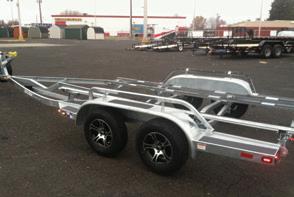

Reliable Quality Service & Craftsmanship For Over 50 Years! Custom Boat Trailers 343 Thain Rd., Lewiston, Idaho www.gateway-materials.com 208-743-0720 • NMMA Certified • All Steel Weld Frame, Fenders & Bunks • 2 YEAR WARRANTY
THE PREMIER SPORTING GOODS STORE ON PRINCE OF WALES ISLAND FOR ALL YOUR FISHING, HUNTING, AND CAMPING NEEDS!
KNOWLEDGEABLE STAFF WILL LET YOU KNOW WHERE, WHEN AND HOW!

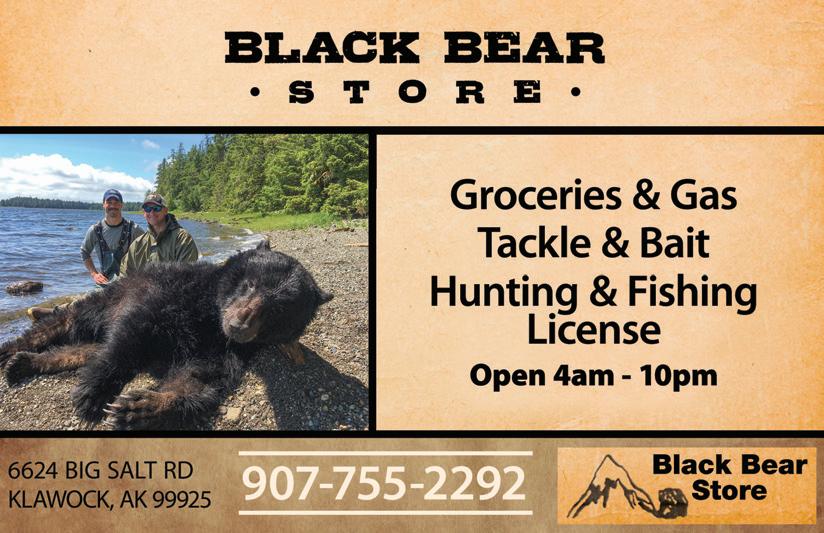








PUBLISHER
James R. Baker
GENERAL MANAGER
John Rusnak
EDITOR-IN-CHIEF
Andy Walgamott
OFFICE MANAGER / COPY EDITOR
Katie Aumann
LEAD CONTRIBUTOR
Frank Jardim
CONTRIBUTORS
Jason Brooks, Larry Case, Graciela Casillas, Ash Hess, Phil Massaro, Fred Mastison, Mike Nesbitt, Paul Pawela, Nick Perna
SALES MANAGER
Paul Yarnold
ACCOUNT EXECUTIVES
Tawna Lucero, Kevin Olive, Tom St. Clair
DESIGNERS
Gabrielle Pangilinan, Lesley-Anne Slisko-Cooper
PRODUCTION ASSISTANT
Emily Baker
WEBMASTER / INBOUND MARKETING
Jon Hines
INFORMATION SERVICES MANAGER
Lois Sanborn
ADVERTISING INQUIRIES
ads@americanshootingjournal.com



12 American Shooting Journal // April 2024
SHOOTING JOURNAL AMERICAN MEDIA INDEX PUBLISHING GROUP 941 Powell Ave SW, Suite 120, Renton, WA 98057 (206) 382-9220 • (800) 332-1736 • Fax (206) 382-9437 media@media-inc.com • www.media-inc.com Website: AmericanShootingJournal.com Facebook: Facebook.com/AmericanShootingJournal X: @AmShootingJourn Volume 13 // Issue 7 // April 2024 ON THE COVER Randy Luth is at both the forefront and center of the modern sporting rifle and its world, having founded Defense Procurement Manufacturing Services and Luth-AR, but he’s so much more than that. Check out Luth’s Q&A with lead contributor Frank Jardim. (LUTH-AR) 406-388-4867 gentrycustom.com/store Where guns are not a hobby, but a way of life Family Owned and Operated. 3-Position
Quiet
Safeties
Muzzle Brakes

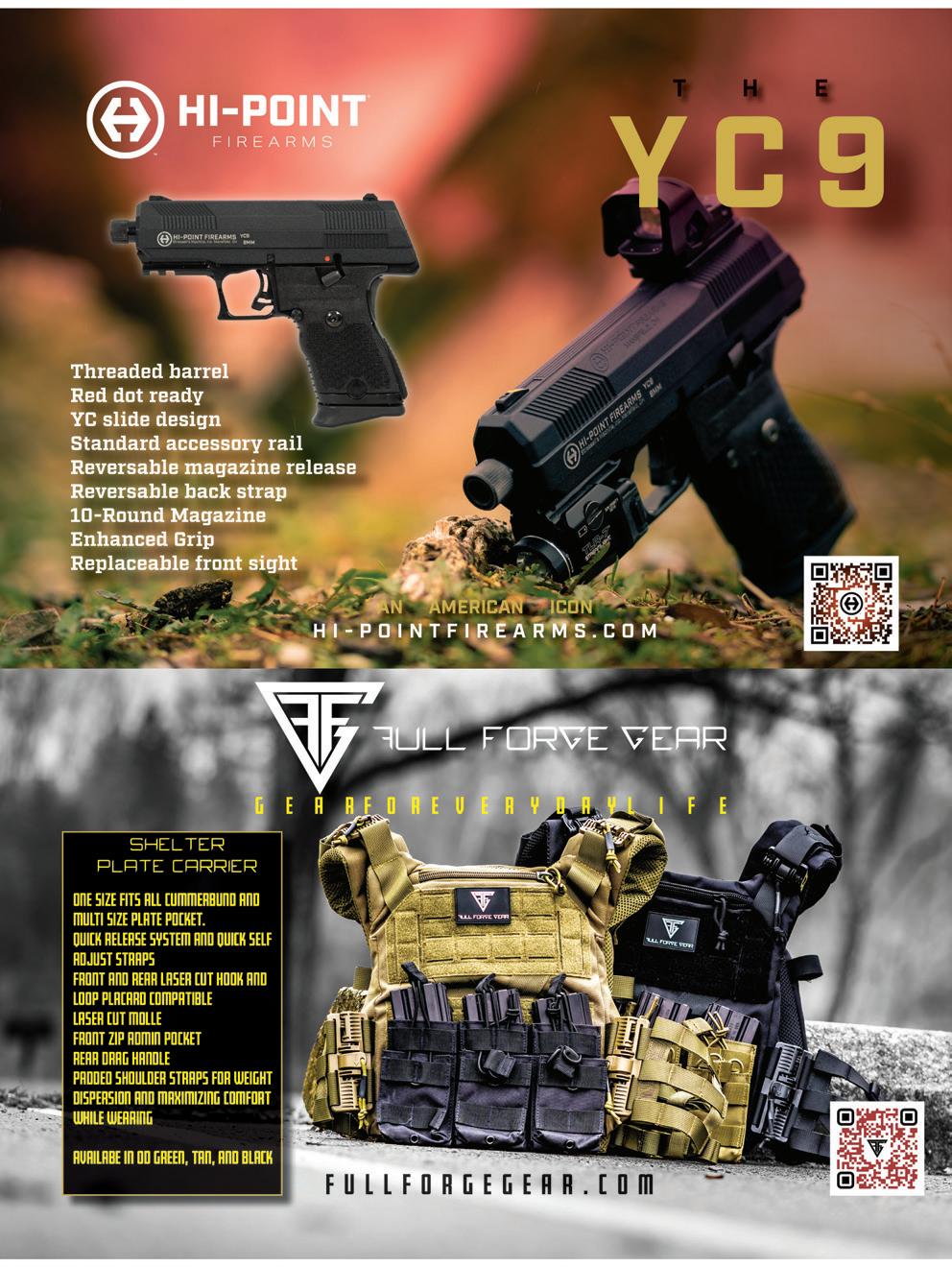
36 GUN REVIEW: COX ARMS USA’S EMR-1
Gun writer Fred Mastison shares his take on Cox Arms’ new Every Man’s Rifle, a feature-rich AR that at just under $1,100 won’t break the bank.
43 RECONSIDERING THE DESIGNATED MARKSMAN
Ash Hess, the guy who wrote the US Army manual on rifle marksmanship, has some thoughts on how to improve the DM role.
49 HOW EXECUTIVE PROTECTION TRAINING HAS CHANGED OVER TIME
Long gone are the days of teaching future bodyguards evasive driving skills at Bob Duggan’s Executive Security International. Instructor Graciela Casillas charts the change to more intelligence-based intervention tactics.
57 WHY MANDATING FIREARM SAFETY TRAINING IS A GOOD THING
Mandatory safety training around universal firearm handling rules would benefit first-time handgun owners and ultimately society at large, argues Jason Brooks.
62 NOTEWORTHY & NEW-ISH WHEEL GUNS
What’s new in wheel gun country? Frank Jardim takes a closer look at Colt’s Anaconda and King Cobra Target .22 LR, Korth’s NXS 8 and Mongoose, Kimber’s K6XS and K6S, and Taurus’s Judge Home Defender.
71 L AW ENFORCEMENT SPOTLIGHT: PRAISE FOR THE DISPATCHERS
Nick Perna shares props for police dispatchers – the vital first link between the public and law enforcement, directing help to where it’s needed asap, and so much more!
74 SC ATTERGUN ALLEY: HITS, MISSES, AND RED DOTS
Mounting an optic on your turkey shotgun will make you a sharper shooter this spring, and Larry Case has a few different brands and models to look at, er, through.
83 BULLE T BULLETIN: THE ALL-AROUND BIG GAME BULLET
Is there really such a thing? Can one size really fit all hunting situations in North America, Africa and beyond? Phil Massaro makes the case for six different projectiles.
105 BL ACK POWDER: LEVER-GUN FUN
Thirty bullets, a bunch of .44-40s, .38-55s and .32-20s, and targets at 25, 50 and 75 yards make for a great new black powder cartridge match, Mike Nesbitt’s found. He shares how his club has adopted a lever-gun competition.

americanshootingjournal.com 15
CONTENTS AMERICAN SHOOTING JOURNAL is published monthly by Media Index Publishing Group, 941 Powell Ave SW, Suite 120, Renton, WA 98057. Display Advertising. Call Media Index Publishing Group for a current rate card. Discounts for frequency advertising. All submitted materials become the property of Media Index Publishing Group and will not be returned. Copyright © 2024 Media Index Publishing Group. All Rights Reserved. No part of this publication may be copied by any means, electronic or mechanical, including photocopying or recording by any information storage or retrieval system, without the express written permission of the publisher. Printed in U.S.A. VOLUME 13 • ISSUE 7 COVER STORY RANDY LUTH AND THE MODERN SPORTING RIFLE Accomplished hunter. Competitive shooter. Founder of two AR-platform companies. One-time newspaper press apprentice. Randy Luth has packed a lot of lives into 70 years, and the world of modern sporting rifles and their fans owe a lot to him. Frank Jardim sat down with Luth for a Q&A on his remarkable career. 24 (LUTH-AR)
FEATURES



Remote, Comfortable & Affordable
Our remote Alaskan fishing lodge is situated on the upper stretches of the beautiful Egegik River. You’ll watch some of Alaska’s most stunning sunrises, complete with a distant, active volcano. We are a fishing camp specializing in coho fishing, brown bear viewing, and flyout fishing adventures to even more remote destinations in the Last Frontier.
Coho Fishing The Egegik River
The Egegik River is touted by many experienced anglers as the best silver salmon stream in all of Alaska. Becharof Lodge On The Egegik River was the first fishing lodge to become established on the breathtaking Egegik River, and is less than a 5 minute boat ride from some of the best fishing holes on the entire river.


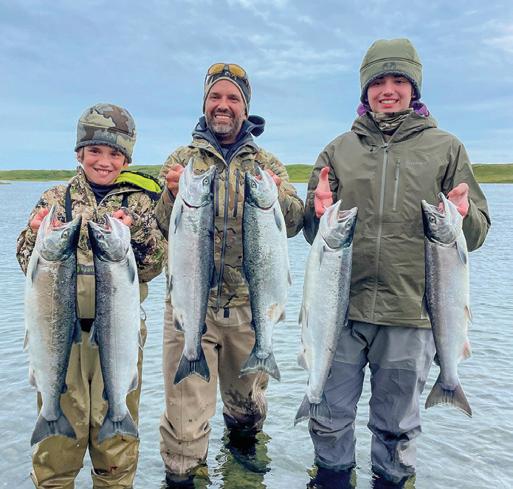

Now Booking for 2024 Coho Fishing Trips
Included in your fishing trip:
• 6 days fishing/5 nights stay in camp
• Experienced, fully guided fishing.
• Comfortable cabins furnished with beds, cozy comforters & bedding.
• Home cooked meals, snacks, and nonalcoholic beverages.
• Transportation from the lodge to prime fishing holes on the Egegik River.

• Freezing and vacuum sealing of your fish, up to 50 lbs., per angler. $4,850
person Includes round trip charter from King Salmon. Call for more details. becharoflodgefishing.com Book Your Trip Today! Mark Korpi: 503-741-1333 or 503 298 9686 George Joy: 360-562-7701 Email: becharoffishing@gmail.com
per



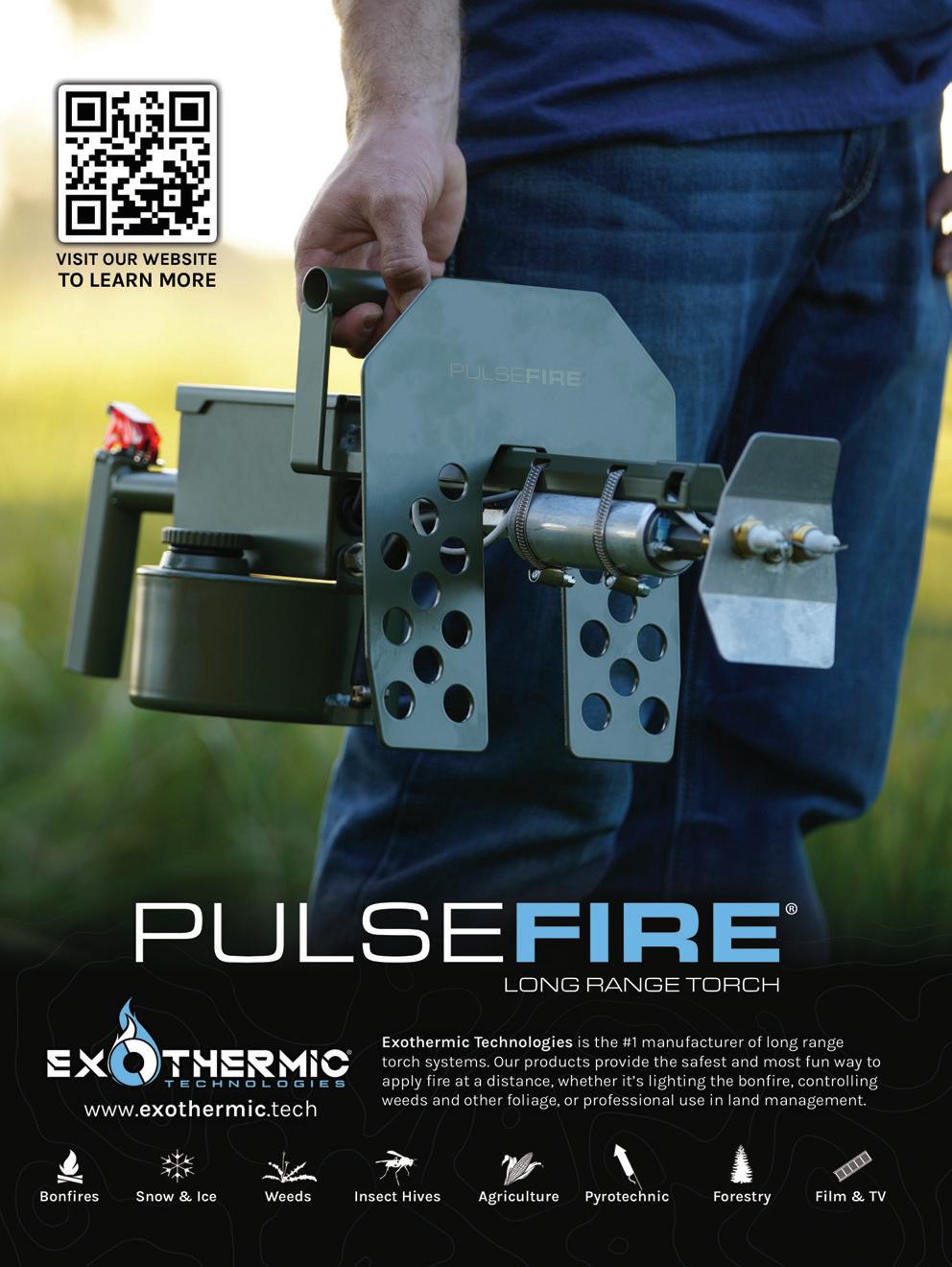


18 American Shooting Journal // April 2024 DEPARTMENTS also inside CONTENTS 96 COMPANY SPOTLIGHT: GRIND HARD AMMO Florida entrepreneur, philanthropist, and art and car collector Barry Skolnick zeros in a new business venture: manufacturing rifle and handgun
Paul Pawela takes a tour of
and well-decorated
21 Gun Show Calendar 23 Competition Calendar 96
ammunition.
his tidy
plant.
(PAUL PAWELA)




20 American Shooting Journal // April 2024 BRASS MASTER ULTRA VIBE CASE CLEANERS THUMLER’S TUMBLER Made of durable steel construction - heavyduty, sealed ball bearing motors - thermally protected - fast, quiet operation - 3/4 to 4 3/4 gallon capacity - industrial and rotary models available. Send for our free brochure! TRU-SQUARE METAL PRODUCTS, INC. P.O. Box 585, Auburn, Washington 98071 TEL (253) 833-2310 or Toll Free 1-(800) 225-1017 www.thumlerstumbler.com t-tumbler@thumlerstumbler.com “Manufacturers of quality case cleaners, deburring and tumbling equipment since 1959”

GUN SHOW CALENDAR
C&E Gun Shows cegunshows.com
Crossroads Of The West Gun Shows crossroadsgunshows.com
Florida Gun Shows floridagunshows.com
G&S Promotions gunshowtrader.com
GunTVShows.com guntvshows.com
Hernando Sportsman’s Club hernandosportsmansclub.com
RK Shows rkshows.com
Real Texas Gun Shows therealtexasgunshow.com
Tanner Gun Shows tannergunshow.com
Wes Knodel Gun Shows wesknodelgunshows.com
April 6-7
April 13-14
April 13-14
April 27-28
May 25-26
April 6-7
April 13-14
April 20-21
April 27-28
April 6-7
April 20-21
April 27-28
May 18-19
May 25-26
April 6-7
May 25-26
April 6-7
April 13-14
May 4-5
April 6-7
April 6-7
April 12-14
April 13-14
April 19-21
April 20-21
April 27-28
April 27-28
April 27-28
May 4-5
April 19-21
May 3-5
April 20-21
April 27-28
May 4-5
Fayetteville, N.C. Crown Expo Center
Dayton, Ohio Montgomery County Event Center
Hickory, N.C. Hickory Metro Convention Center
Concord, N.C. Cabarrus Arena & Event Center
Winston-Salem, N.C. Winston-Salem Fairgrounds
San Bernardino, Calif. National Orange Show Grounds
Las Vegas, Nev. Las Vegas Motor Speedway
Sandy, Utah Mountain America Expo
Phoenix, Ariz. Arizona State Fairgrounds
Fort Myers, Fla. Lee Civic Center
Tampa, Fla. Florida State Fairgrounds
Miami, Fla. Miami-Dade Fairgrounds
Orlando, Fla. Central Florida Fair Grounds
Miami, Fla. Miami-Dade Fairgrounds
Mountain Home, Ark. Baxter County Fairgrounds
Elk City, Okla. Elk City Civic Center
Fountain Hills, Ariz. Fountain Hills Community Center
Phoenix, Ariz. Ben Avery Shooting Range
Tucson, Ariz. Tucson Expo Center
Brooksville, Fla. Hernando Sportsman’s Club Range
Grovetown, Ga. Columbia County Exhibition Center
Joplin, Mo. VFW Post 534
Murfreesboro, Tenn. Mid-TN Expo Center
Sullivan, Mo. Knights of Columbus
Kansas City, Kan. Wyandotte Fairgrounds
Valdosta, Ga. Lowndes County Fairgrounds
Gainesville, Ga. Galaxy Event Hall
Belton, Texas Bell County Expo Center
Brenham, Texas Brenham Fire Dept. Training Center
Aurora, Colo. Arapahoe County Fairgrounds
Denver, Colo. Crowne Plaza
Redmond, Ore.
Deschutes County Expo Center
Centralia, Wash. Southwest Washington Fairgrounds
Albany, Ore. Linn County Expo Center
To have your event highlighted here, send an email to kaumann@media-inc.com.
americanshootingjournal.com 21
PRIMER


COMPETITION CALENDAR

usashooting.org

uspsa.org
April 1-11
USA Shooting National Junior Olympic Rifle Championship
Colorado Springs, Colo.
April 10-14
IPSC Nationals
Mesa, Ariz.
April 19-21
12th Annual Gary “Doc” Welt
Memorial Match
Pinellas Park, Fla.
April 11-18
USA Shooting National Junior Olympic Pistol Championship
Colorado Springs, Colo.
April 26-28
Delmarva Section Championship
Hedgesville, W.V.
April 26-28
Texas State Open Championship
Wallis, Texas

gssfonline.com
April 6-7
Delaware State GSSF Challenge
Bridgeville, Del.
April 6-7
Sweet Home Alabama Glock Challenge
Shorter, Ala.
April 13-14
Old Dominion Glock Challenge
Hurt, Va.

cmsaevents.com

idpa.com
April 5-7
AZ State Championship
Queen Creek, Ariz.
April 10-13
CMSA Extravaganza
Shelbyville, Tenn.
April 11-14
Rollin’ on the River IDPA Championship
Valdosta, Ga.
April 12-14
Virginia Indoor Regional
Chesapeake, Va.
April 13-14
Gem State Classic
Nampa, Idaho
April 20-21
Homestead Glock Challenge
Homestead, Fla.
April 27-28
BSR Glock Challenge
Summit Point, W.V.
April 21-28
Paralympic Trials Part 3
Anniston, Ala.
May 2-5
Ohio State Buckeye Blast
Marengo, Ohio
May 16-18
Alabama State Championship
Woodville, Ala.
May 16-19
Area 1 Championship
Winnemucca, Nev.
April 27-28
Emerald Coast Glock Classic
Holt, Fla.
May 4-5
Foothills GSSF Match
Cherryville, N.C.
May 4-5
Silver State Glock Showdown
Reno, Nev.
April 19-21
Red Bluff Round-Up Rodeo
Red Bluff, Calif.
April 27-28
Missouri State Championship
Festus, Mo.
April 19-20
Arkansas State Championship
Perryville, Ark.
April 26-27
Maryland State Match
Lexington Park, Md.
To have your event highlighted here, send an email to kaumann@media-inc.com.
May 3-4
Utah State Shoot
Kaysville, Utah
May 4-5
South Pacific Regional Championship
Tehachapi, Calif.
April 27
Western Washington Regional IDPA Championship
Puyallup, Wash.
May 3-4
Oklahoma State IDPA Championship
Tulsa, Okla.
americanshootingjournal.com 23
PRIMER
 Randy Luth once aspired to a career in printing, but when his interest in that waned, he turned to machining, a very profitable decision that eventually led to Luth’s founding of Defense Procurement Manufacturing Services and Luth-AR.
Randy Luth once aspired to a career in printing, but when his interest in that waned, he turned to machining, a very profitable decision that eventually led to Luth’s founding of Defense Procurement Manufacturing Services and Luth-AR.

THE MAN, THE MYTH, THE LUTH
The present generation of American shooters have grown up in what we might call the Era of the Modern Sporting Rifle. I am a few generations removed from that younger crowd, as are many of our elected representatives in the state and federal legislature. To younger shooters, it must seem bizarre to hear some politicians and others refer to the MSRs commonly used for hunting, competitive shooting and the defense of life and property as assault rifles and weapons of war.
What many of the new generation of American shooters don’t realize is that those trying to ban their MSRs have been making the same spurious arguments for over 40 years, and beginning in 1989, they actually succeeded on the state and federal levels, banning scores of semiautomatic, military-looking “assault rifles” for the next 15 years!
Today's 'Era of the Modern Sporting Rifle' has a lot to do with Randy Luth, who has been at the forefront of AR product and rifle development for target shooters, competitors and hunters over the decades.
It might surprise younger shooting enthusiasts that the bans had some help from rather old-fashionedminded elements in the shooting sports community, particularly hunters, as well as conservative politicians you would have expected to oppose these obviously unconstitutional gun bans. Knowing that, it begs the question: How did we ever get today’s Era of the MSR?
Part of the answer to that question is the subject of this month’s interview. Randy Luth is perhaps best known as the founder and former president of DPMS Panther Arms. Under his leadership, DPMS supplied parts to the military as well as their private sector civilian competitors, developed and manufactured dozens of improved concept components and firearms, and pioneered manufacturing processes for the industry that are now common practice. They were one of the earliest and most successful
producers of AR-style firearms for the civilian market and played a big role in reshaping how American shooters, and the gun industry, thought about them. He’s also founder and current president of Luth-AR.
Luth’s many documented hunting accomplishments demonstrate a methodical passion for the sport that is rare even among the most enthusiastic and well-to-do hunters. For example, five years ago he completed the Super Slam of North American Big Game, having successfully hunted all 29 species on the list, which includes everything on the continent that can kill and eat you, as well as all the big antlered and horned animals that can batter, gore or stomp you to death, but won’t eat you. Only 235 hunters are known to have achieved this lofty goal since recordkeeping began in the early 1970s. Luth was the 167th.
He’s also a longtime participant and supporter of the action shooting
americanshootingjournal.com 25
STORY BY FRANK JARDIM • PHOTOS BY LUTH-AR
 Luth, 70, competing in the recent 2024 Superstition Mountain Mystery 3-Gun Championship in Arizona, where he took second place in the Open Division Super Seniors category.
Luth, 70, competing in the recent 2024 Superstition Mountain Mystery 3-Gun Championship in Arizona, where he took second place in the Open Division Super Seniors category.


sports, and, at 70 years old, he is still heavily involved in 3-gun competition. On the evening I spoke with him, he was preparing to compete alongside Jerry Miculek in the Super Seniors Division at the Superstition Mountain Mystery 3-Gun match, one of the biggest and oldest 3-gun competitions in the country.
Frank Jardim When I was researching your achievements, I was struck by the huge amount of mental and physical energy you’ve expended on the AR platform in the last 40 years. I had to ask myself, “Is this guy in love with the AR-15?”
Randy Luth It became a love thing, but it didn’t start that way. My life is a ragsto-riches story and the AR platform provided the means for me to achieve the American dream. My father was a janitor and mother was a waitress. They were hardworking poor. You know, the house my whole family lived in would almost fit inside of the garage of my house today.
When I graduated high school in 1972, college was not an option for me. I had to start earning a living and my plan was to get into printing. I was lucky to get an apprenticeship lined up with the Minneapolis Star and Tribune, but not where I expected. They put me in
the press room and even though it was decent money at $4 an hour – I think minimum wage then wasn’t more than $2.25 – I realized it wasn’t for me.
I left that newspaper and went to work for my friend doing precision grinding. Getting into a machine shop and learning the capabilities of tools and how to use them was the foundation of my later success as a manufacturer. I made a lot of parts in the years I ran the machines. Shops big and small, all around the country, make the parts that are put together into the products we use every day. It so happened the job shop I worked at was making M16 parts for the government. That fed right into my largely unexplored interest in firearms. I got my first AR-15 around 1985, shortly after I was promoted off the shop floor into a sales engineer position.
FJ In the late 1970s and early 1980s, I recall the AR-15 was something of a curiosity when it occasionally made an appearance at a civilian range. You just didn’t see them very often outside of TV shows and military bases. They weren’t in every gun shop.
RL That’s right. And the only ones made were Colt’s semiauto clones of their military models. After Colt’s patents expired in the 1970s, other gunmakers,
americanshootingjournal.com 27
Well known for a wide variety of AR-related advancements, Luth directly credits participating in shooting competitions for the creation of an oversize bolt catch, handguard and a pair of grips, one of which is ambidextrous.


like my company DPMS, got the opportunity to experiment with the platform and tap into its full potential as a civilian sporting rifle and also a personal defense weapon. Bushmaster and Olympic Arms were the first to go in big on the AR in the early 1980s and their success helped push me into the firearms industry. It was still a very small civilian market at that time, but through the course of my work as a sales engineer, I learned some things they didn’t know and developed my own ideas about how to make an AR platform that was accurate, practical and more appealing to the regular American recreational shooter.
FJ What was it that you learned that made you sure you could compete in the niche AR market against two wellestablished and respected firearms manufacturers?
RL It all came down to the parts. I was the go-to guy for military and aftermarket AR parts years before I started making guns. Several things in my career laid the groundwork for that.
In the nearly 10 years I spent as a machinist making all types of parts on the shop floor, I learned how to read blueprints, select tooling, design and make fixtures, set up machines, and gauge parts and cutting tools to ensure the finished product met the tolerance requirements of the customers. As a gun enthusiast and a machinist, I saw where changes in the military specification could be made to improve performance in ways that would appeal to the civilian market. At the expense of accuracy, the military enlarged the dimensional tolerances of many parts to improve reliability in severe combat environments. Looser parts tolerances also reduces the cost of large-scale production, a benefit to the taxpayer. But how many hunters or target shooters demand a rifle they can chamber muddy ammunition in? The civilian market wants accuracy in a rifle, so it was obvious to my machinist eye that military tolerance specifications needed to be tightened up.
In 1986 I formed DPMS, Defense Procurement Manufacturing Services, as a government contract consulting company where I would seek out DoD
28 American Shooting Journal // April 2024
Luth is also an accomplished hunter who has taken a wide range of game, from an African crocodile in Zimbabwe ...
... to a Rocky Mountain elk with a bow near Mormon Lake, Arizona ...
(Department of Defense) solicitations for my manufacturing clients. I used the knowledge I got making parts to find work suitable for my clients’ capabilities and prepare bids. During this time, I also took an MBA-level course in government contracting so I could learn how to manage my clients’ DoD contracts. Funny thing about that was that the university wouldn’t let me at first because I wasn’t a student there and only had a high school diploma. That class turned out to be very important for my future because it led me directly into the AR parts business.
Some of those DoD contracts were for gun parts. I’d keep records of which company made what, and used the FOIA (Freedom of Information Act) process to learn about other companies making military rifle parts that I hadn’t worked with directly. When Bushmaster, Olympic, Essential Arms, or whoever, called me up needing parts, I’d find the shop that made it for the government and offer to buy their overruns. They usually had overruns they were happy to unload. If they didn’t, I’d get them to make another run for me to sell to my customer.
Eventually, I ended up buying all the overruns and warehousing them. There weren’t many people dealing in AR parts at that time, and the surplus dealers as a general rule won’t guarantee the quality of the parts they sell. It’s one thing for a home builder to buy a part for his or her own gun, but manufacturers are liable for their product, so mystery surplus parts don’t have a lot of appeal to them. The big AR makers bought parts from me because they knew they would be right. What they didn’t know was where I was getting them made and that was my edge in the AR business.
FJ If you were doing so well as a government contract consulting company, why did DPMS finally move into building complete rifles?
RL I had my own ideas for the platform that came out of years of dissecting the government parts blueprints and thinking about how to change them to make rifles shoot better. In 1992, I got a manufacturing FFL (Federal Firearms License) and started applying those ideas. I wanted to work


americanshootingjournal.com 29
... to a bull with his AR-10 in .308 in Crested Butte, Colorado. He reports taking about half of the 29 big game animals comprising the North American Grand Slam with AR rifles in various calibers.
... and from a desert bighorn sheep in Mexico ...
with 24-inch fluted bull barrels for better accuracy. The fluting stiffened the barrel and improved the heat dissipation and looked cool. I closed up certain tolerances in certain places for improved balance, harmonics, concentricity. Tolerancing and dimensioning was key. Holding tight tolerances causes you to use up a lot of tooling. For example, I would only ream 200 DPMS barrel chambers before I had to replace the reamer. Guys making the larger tolerance military barrels would do 1,000.
FJ How many patents do you have?
RL Nine at the moment, with a few pending. All of them are related to the AR and most of them still relevant today, I believe, but patents alone don’t make you an industry leader. Trying new things does. I launched a lot of revolutionary, innovative new products, such as left-handed receivers, cast stainless steel and cast titanium lower receivers, and a pump-action AR. DPMS was the first to use titanium nitriding on bolts, bolt carriers, hammers, triggers and disconnectors. In the late ’70s, I was impressed at the superior durability of titanium-nitride-coated drill bits and got the idea to use it on our fire control parts. The added lubricity alone cut a pound off the trigger pull. That decision had a broad impact on the industry as we see today.
DPMS was also the first to apply Teflon impregnating to the magazine anodizing process. Without it, magazines sometimes came out an ugly, blotchy grey. It’s hard to sell an ugly magazine. Teflon impregnating gave them an attractive uniform finish and improved lubricity as a bonus.
We were the first to market a multirail system. In 1991 at the SHOT Show, some Aberdeen Proving Ground suits were going crazy over the tri-rail mount we developed for our flat-top upper receiver that let you mount accessories on the top and both sides. They’d never seen anything like it before. We also developed the first quad-rail gas block. Ultimately, it was the military’s concept that won in the end, evolving into the present-day forend quad-rail system.
My Glacier Guard heat-resistant,
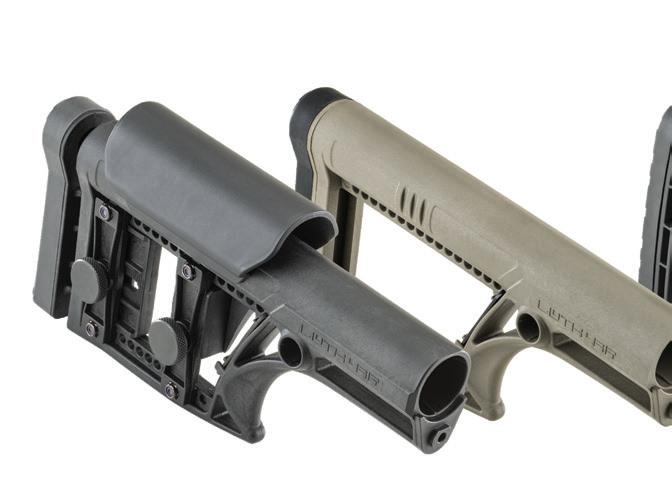
injection-molded nylon handguard was a solution to the manufacturing challenge of attaching sheets of aluminum to the inside of thin plastic handguards. I thought it was my best idea, but after Remington bought us out, they never did much with it. Heat absorbing and dissipating ribs were molded inside. It met the military requirements. You could fire seven 30-round magazines, one after the other, in full auto and it didn’t get too hot to hold.
Several times our rifles were recognized by the industry for their excellence. The Panther LR-308, an AR10 type, earned Shooting Illustrated’s 2005 Golden Bullseye Award for “Rifle of the Year.” Then the next year, another one of our AR-10 guns, the Panther LR308AP4, earned the Golden Bullseye Award for “Rifle of the Year” from American Rifleman. We were the first MSRs to get a Golden Bullseye award.
FJ Speaking of your AR-10s, was the .308-sized AR platform your preferred big game hunting rifle?
RL It’s excellent in that role. The .308 is such a popular and long-established caliber that it offers a wide variety of bullet types to match to the job. Since I started my big game hunting with the big AR platform in 2001, ammunition options have really expanded for the standard AR platform, making it very versatile as a hunter too. But 20 years ago there was less to choose from;


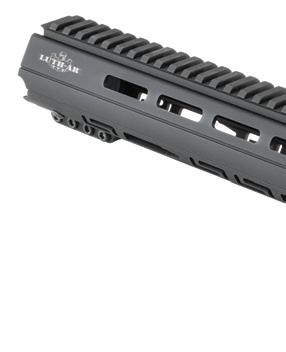

30 American Shooting Journal // April 2024
MBA-1 Rifle Buttstock.
The Switch Extended Selector.
Lightweight Palm Handguard.
Palm Handguard.
Widebody Handguard.






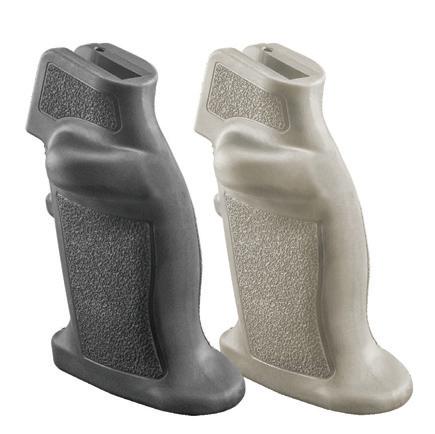
americanshootingjournal.com 31
The Ambi-Switch Extended Selector.
The Wing Grip.
The Chubby Grip.
MBA-3 Carbine Buttstock.
MBA-4 Carbine Buttstock.
MBA-5 Carbine Buttstock.
fewer states allowed semiauto rifles for hunting or drew the minimum caliber line above .223. The AR-10 I hunted with in the beginning was to demonstrate proof of concept that the platform wasn’t limited to military purposes just because it looked similar to a military rifle. The AR was being pigeon-holed by big segments of the shooting sports community. Before approximately 2003, Outdoor Life magazine had never run an advertisement for an AR-type rifle. I believe DPMS ran the first. In an accurate DPMS rifle, the .223 was just fine as a varmint hunter. I shot half of the North American Grand Slam’s 29 species with ARs of various calibers, and a lot of African game too.
In 2001, I took the prototype DPMS .308 semiauto to Alaska on a mountain goat hunt. Carrying it up and down the mountain, it was immediately clear to me that it was too heavy, so I redesigned it. In 2009, I took our first single-shot, gas-operated .308 AR-style rifle to Africa to hunt. It’s illegal to bring a semiauto rifle into South Africa and Zimbabwe. This has less to do with game laws than it does with the governments down
there worrying about them getting stolen by anti-government rebels. To my knowledge, in 2009 I was the first person to hunt in Africa with an AR-style rifle. I got a leopard with it, among other plains game animals.
FJ Trying to explain the AR’s rise in popularity since I bought my first one, a Colt SP-1, in the early 1990s, I’d speculate it was due to the platform maturing technologically and shooters gradually recognizing its capabilities. Cheap 5.56 ammo, at least before Covid, helped too, as did the improved caliber offering that made it versatile for hunting. And finally, there’s the appeal of being able to personalize the platform to your tastes with an ever-expanding range of custom parts and accessories. However, I’m not sure how much of the “Shooter’s Barbie” situation, or any of these factors, is actually a driver of popularity or an effect of it. RL All valid points, but there are some social aspects to the AR’s rise in popularity that might really be the most important. Desert Storm stirred the market. From the First Gulf War

onward, the public had a highly favorable attitude toward the military and the military had a favorable attitude to the AR platform. Several million soldiers experienced it, liked it, and as veterans, they wanted to own one. Admirers of the military wanted to own one too.
FJ So the AR had become “America’s rifle” in a way it hadn’t during the Vietnam War?
RL Yes. But there’s still more to its surge in popularity than innovation and military service. Nobody realized how big the AR market was before 2007. That year, Bushmaster and DPMS made approximately 125,000 rifles each and it was thanks to superanti-gun presidential candidates Barack Obama and Hillary Clinton.
FJ So nothing drove AR sales so hard as people thinking they would be banned?
RL So it seems. Gun sales volume also increases in time of social unrest. The Covid stuff and all the riots around the country drove a huge spike in sales to the point of creating a nationwide gun shortage, AR platforms included.
32 American Shooting Journal // April 2024
One thing is for sure: Whether searching for caribou in Greenland (pictured) or looking to bring an insight from the field into product development, we’ve certainly not heard the last of Randy Luth.

FJ In 2013 you formed Luth-AR LLC, your present company, and once again you’re specializing in parts. It seems like you can’t stay away.
RL Custom parts to make the AR shoot better were always a big interest for me. I’ve done a lot of hunting and competition shooting since I sold DPMS and that’s how you get good ideas. For example, the DPMS/Luth-AR Extended Safety Selector was born in the aftermath of an intense five-day carbine class I took in 2000 that left me thinking the standard safety lever was a little too small to readily manipulate. I used modeling clay to design a new one and then had it made up in the shop. It was the first oversized safety selector on the market. We’ve sold tens of thousands of those things. The insight to recognize the need for something like that comes from being a serious shooting enthusiast, not an MIT engineer.
It was the MBA stock that actually instigated me to form Luth-AR. I was a bit insulted that the new owners of
DPMS didn’t want to use my idea, so I decided I’d make it myself after our non-compete agreement expired. MBA stands for Modular Buttstock Assembly. Cheek weld on the stock is really important for consistent shooting with iron sights and even more so with telescopic sight. To use a telescopic sight efficiently, your cheek weld needs to put your eye at the correct height and distance from the objective lens naturally when you shoulder the rifle. The MBA lets you do this because it’s fully adjustable for length-of-pull and comb height.
Getting back to the importance of being a shooter in understanding what shooters need, my competition shooting led to the creation of The Paddle oversize bolt catch; the flat-bottomed Tri-Lobe Palm Handguard, which steadies the forend on obstacles more effectively than a round forend; and the Chubby Grip and ambidextrous Wing Grip, which help consistently position your shooting hand for a solid hold and more ergonomically comfortable and
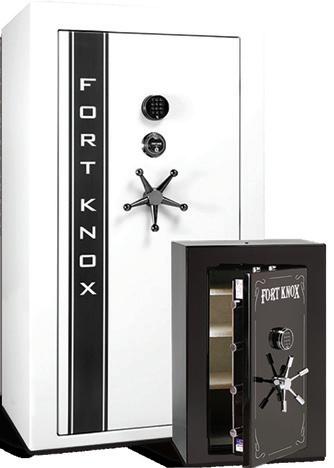

consistent control of the trigger for accurate shooting. I use this stuff on my rifles because it helps me shoot better with them.
FJ In 2017, you also got back into the business of making standard AR parts again. Was that in anticipation of that retro AR trend that emerged recently?
RL No. We started making what you call standard mil-spec parts again because we saw a serious decline in the quality of parts over several years, mostly with foreign imports but also among some made domestically. I wouldn’t put those parts on a gun, but people that didn’t know better – and some that did but didn’t care about anything but cost – used them and the result is poor-quality finished rifles. We got back into making standard parts because there was need for them again and we have the know-how to make high-quality parts, right here in America, at an affordable price. ★
Editor’s note: For more information on Luth-AR, visit luth-ar.com.

34 American Shooting Journal // April 2024
AZSAFES.COM 480-497-3882 • UNIBODY CONSTRUCTION Fort Knox has folded the edge around the door, making it virtually impossible to pry. • SUPERIOR FIRE PROTECTION Fort Knox Vaults will protect your possessions with a Reinforced Fire Liner option. • POWER SUPPLY INSIDE All Fort Knox Defender Vaults & above come standard with an internal power supply. • DRILL STOP HARD PLATE Bearings are recessed into the hard plate and will cause drill bits to slip and break. • 5 TO 1 GEAR DRIVE SYSTEM Our patented rack & pinion bank locking drive is the most reliable locking system available. • HEAVY DUTY CORNER BOLTS Securing the corners of the door to prevent attacks on Guardian, Titan, and Legend vaults. • QUADRAFOLD DOOR FRAME The Quadrafold Door Frame has been designed to be the strongest in the industry. • MANIPULATION PROOF LOCK Our UL Listed Group II mechanical lock resists manipulation & “safe cracking” attempts. AMERICAN MADE FROM AMERICAN STEEL PROTECT WHAT’S IMPORTANT TODAY THE MOST SECURE AND FIREPROOF VAULTS

The Premier Manufacturer of AR Triggers

ELF Glock Trigger



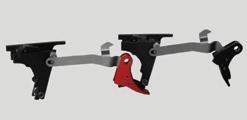
Introducing the ELF Glock Trigger, for Glock Gens 1-4. This advanced trigger is engineered for precision, featuring a short creep and a glass-like break that guarantees swift and accurate firing. With an adjustable pull weight ranging from 1 1/2 to 3 1/2lb, this trigger caters to individual preferences for a personalized shooting experience. The aluminum trigger shoe, available in sleek black or vibrant red, brings style and also ensures durability. Crafted from A2 steel, the ELF Glock Trigger delivers both longevity and reliability, utilizing the Glock’s stock firing spring and stock safety spring for full ignition. The Glock Slide will need to be milled which ELF offers as a service.
ELF APEX Trigger


APEX-PRO-R-S APEX-B-C-FA
The ELF APEX Trigger has been built for performance. Pull weight is so easy to adjust it can be done in seconds without removing the trigger from your lower receiver. A second-to-none AR-Platform drop-in trigger system that is strong and light, made of wire EDM machined, hardened A2 tool steel and lightweight aircraft-grade aluminum. Available with a curved or straight shoe along in black or red. It can also be purchased in our Pro Lock Threaded Mounting System.
The amazingly short take-up, glass-rod crisp break, no skip technology and our new adjustable sear lets you customize the over-travel can be compared to the finest custom 1911 triggers. If you are looking for the finest adjustable trigger for your AR platform, this is the trigger system for you.
The ELF-SE Drop-In Trigger maintains the Elftmann reputation for quality, craftsmanship and customer service in an affordable package. Extremely short takeup, clean crisp break and very short, positive reset. It has a brand new look and features such as, an adjustable pull weight being one of them! Available in our Pro Lock Threaded Mounting System. Fits any and all AR platforms (large pin Colt available) with features including: Drop-safe, adjustable from 2 3/4 to 4lbs without removing from lower, Patented Double-Double torsion hammer spring, short pull and reset allows for rapid follow up shots, lightweight aircraft-grade aluminum and hardened steel construction, design of disconnector allows full 1/4” width eliminating possibility of wear and double-firing, adjustable aluminum trigger shoe (available in straight or curved, red or black)
ELF SE Trigger


elftactical.com | elftacticalmarketing@gmail.com | 602-441-5007 SE-R-C-FA SE-PRO-B-C

COX ARMS
USA’S EMR-1
Arizona manufacturer’s feature-rich AR a ‘serious rifle’ that at just under $1,100 won’t break the bank.
The EMR-1, or Every Man’s Rifle, features a safety and charging handle that are both ambidextrous.
gun review


The AR-15 is possibly the most tinkered-with, modified, and experimented-with gun of all time. Companies have spent countless hours poring over designs and specs in an attempt to essentially create a better mousetrap. In some cases, real advancement is made, while other efforts are not as fruitful. In each instance, these advances have been minute and sometimes unnoticeable. Like many of you, it takes quite a bit for me to take a serious interest in “design advancement.” The major sticking point for most companies is price point. There seems to be an inability for major companies to build a high-end AR at less than stratospheric prices.

Enter Cox Arms USA from San Tan Valley, Arizona, just on the edge of Phoenix. When Michael Cox, owner of Cox Arms, took a hard look at this challenge, he simply
americanshootingjournal.com 37
STORY AND PHOTOS BY FRED MASTISON
said, stand by. The result is the EMR-1, which stands for Every Man’s Rifle.
The EMR-1 is one of the most feature-rich guns I have seen in its price range. The EMR-1 starts with a 7075-T6 aluminum forged receiver set. Inside the upper, Cox Arms uses an enhanced bolt carrier group. These BCGs go through both magnetic particle inspection and high-pressure testing to ensure quality. The EMR-1 has a midlength gas system, and the barrel is a 16-inch government profile 5.56 NATO machined from 4150 CrMoV steel with a 1-in-7-inch twist.
Cox Arms takes time to ensure the durability of the EMR-1. One example of that is Rocksetting the screws in the gas block. Over the barrel is a 13-inch lightweight anti-rotation, steel-on-steel retention handguard. The barrel is finished with Cox Arms’ high-performance Battle Brake muzzle device. The Battle Brake is the gold standard in muzzle devices.
Another example of the quality and high-performance design of the gun is the inclusion of an Elftmann Tactical trigger. The Elf-SE trigger has a pull weight of only 3.5 pounds and is set inside an enhanced trigger guard for a sleek complementary look. The EMR-1 has both an ambidextrous safety as well as an ambidextrous charging handle to make operation

Other notable features of the EMR-1 include an upgraded H1 buffer, a threaded pin for the bolt catch, a threaded pin for the forward assist, captured rear take-down pin detent/ spring, and an upper receiver tension screw. Coming in at only 6.6 pounds, it is an exceptional rifle that can serve a spectrum of needs.
AS WITH ANY rifle with significant buzz, it is always best to get it on the range to get proof of performance. With claims being put forward on the EMR-1, it had to be quantified with some old-school target shooting. Range day would be pretty straightforward and focused on performance.
Our day began early as the rifle case
Mastison during range testing with the rifle. easier. Following the ease-of-operation idea, Cox Arms has also designed a double-beveled magwell for easier and faster reloads. Finishing the gun out are the B5 Systems P-23 grip and Bravo stock with six-position adjustment; this furniture will be available in five different colors (black, coyote brown, wolf grey, OD green and FDE) that the customer can choose from.
was cracked open. While the goal is to be impartial, the rifle is good-looking. It is obvious that a lot of work went into the design. A lack of sharp edges, tight tolerances and overall feel put this gun in a good light before the first magazine was even loaded. The fit and finish on the rifle were good. The rifle was obviously hand-fit because there was no play between the upper and lower. There was no rattle in the gun, which is a downfall of lesser quality guns. The rifle was finished out with an EOTech XPS2 Holographic Weapon Sight. This would fit our testing applications well.
The weather was perfect, as the late Arizona spring provided clear, comfortable conditions. The first order of business was the gathering of data on groups. As we started the zeroing process, I began to get a feel for the rifle. The first thing I noticed was the trigger. It
38 American Shooting Journal // April 2024
gun review
With an overall weight of 6.6 pounds, the EMR-1 is on the lighter side. Cox Arms’ Battle Brake reduces muzzle rise by 42 percent and impressed author Fred
broke cleanly with a firm reset and equal travel backward and forward. A good trigger can make or break a gun and this one is a winner. The fact that Cox Arms includes an Elftmann Tactical trigger is just one example of them making this gun more than a boring off-the-shelf shooter.
Running the gun turned out to be déjà vu all over again. The overall operation and reliability of the rifle were
exactly like earlier Cox models I have run in the past. The true ambidextrous nature of the rifle took just a moment to acclimate to. It is worth noting that once you experience the benefit of this design, your other rifles will be seen in a less than glowing light. The design allowed for smooth and efficient operations, and the rifle shined when I did support-side drills shooting left-handed.
When the serious shooting began, I ran the gun as I would during a class. That included targets from 3 yards to 100 yards. In every drill, the rifle performed well. When I tested for accuracy, I was able to shoot a couple of 2-inch groups back to back using Federal Gold Medal Berger 73-grain bullets.
I found the B5 furniture to be a strong addition to the gun. It fit my hands well and seemed like a perfect fit for the gun. It was mostly free of harsh edges and offered a good balance between grip and smoothness. The lightweight nature of the gun made it a breeze to run in any drill and even from nontraditional shooting positions.

Another item I need to shine a special light on is the lack of muzzle rise. Again, Cox Arms uses their own Battle Brake muzzle device, and while I am very public about my feelings on brakes, this device worked. In fact, it performed better than any brake I have ever shot. Cox Arms put significant design and development into the device. What they ended up with was a device that reduces muzzle rise by 42 percent. This was determined through testing the brake on a recoil measuring device. The muzzle devices have gotten so much attention that Cox Arms is selling them by themselves on their website.
WHEN CONSIDERING APPLICATIONS for this gun, the two that stand out most are as a home protection weapon and a hunting rifle. The lightweight and easy-to-run nature of the EMR-1 makes it a natural fighter. It is also a lot of gun for the money. Rare is the company that puts so many high-end features into a blaster without jacking the price up so high you need oxygen to view it. Cox Arms has hit this one out of the park and I have a new gun to recommend to new and experienced shooters alike.
“In a world where people think they’re getting 10 pieces of real chicken for $0.99
americanshootingjournal.com 39
gun review
and quality AR-15s for $299, we set out to create an all-American-made AR-15 that is financially obtainable to pretty much everyone,” states Michael Cox. “We do understand that not everyone has a $2,000 budget, so we set out to create a more affordable, feature-rich rifle made with quality parts that even some of the higher-end rifles don’t have. It’s very important to us that our company provides our customers with the best products possible for the money,
knowing that your life may depend on it!”
The Cox Arms EMR-1 is an exceptional rifle and would be considered so at twice its price. If you are interested in getting a serious rifle without breaking the bank, the EMR-1 is your rifle. For more, see coxarms.com. ★
Editor’s note: Author Fred Mastison has written over 2,000 print articles in dozens of magazines. He is also the founder of Force Options USA, a training
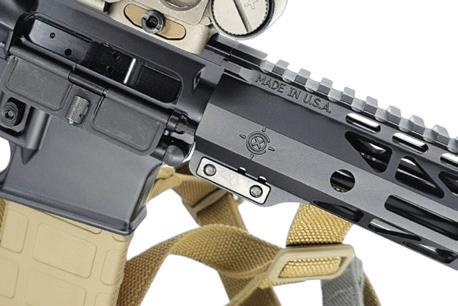

COX ARMS USA EMR-1 SPECS:
• 100 percent American-made;
• 7075-T6 aluminum forged upper/lower;
• Type III hardcoat anodized;
• 16-inch government profile 5.56 NATO, 1:7 twist, 4150 CrMoV barrel;
• Midlength gas system;
• Rocksett gas block screws;
• Elftmann Tactical trigger (3.5-pound);
• Enhanced trigger guard;
• Enhanced bolt carrier group (8620
company for various uses of force, from hand-to-hand training to all levels of firearms training. Mastison is also one of the country’s top professional firearms and combative instructors and a certified dignitary protection specialist. He has taught for over 30 years and has over 16 law enforcement post-instructor certifications. In addition, he’s taught martial arts for 28 years and holds multiple black belts, including a seventhdegree black belt in aiki jujitsu.


carrier/9310 bolt, MPI, HPT);
• Cox Arms USA Battle Brake muzzle device;
• Ambidextrous safety;
• Ambidextrous charging handle;
• B5 Systems furniture with six-position adjustment (five color options);
• Upgraded H1 buffer;
• 13-inch lightweight anti-rotation, steelon-steel retention handguard;
• Double-beveled magwell for easier reloads;
• Threaded pin for bolt catch;
• Threaded pin for forward assist;
• Captured rear take-down pin detent and spring;
• Upper receiver tension screw;
• One 30-round PMag;
• Range bag;
• 6.6 pounds overall weight;
• Lifetime guarantee;
• $1,099 retail/MAP.
40 American Shooting Journal // April 2024
Closeups of various features of the EMR-1.






42 American Shooting Journal // April 2024 AR Rifle Available In 45 ACP and 10mm Bishop EXODUS AR45TC

RECONSIDERING THE DESIGNATED MARKSMAN
The role of the designated marksman, or DM, has been around since firearms came into battle. Out of every formation, someone always rises to the top when it comes to shooting prowess. The difference between this individual and a sniper is that the DM is part of the squad, not an attachment. This is clear in the US Army’s field manual, ATP 3-21.8 Infantry Rifle Platoon and Squad. The DM does not operate independently of the squad, nor engage targets at extreme range. The DM will have an “optically enhanced rifle” compared to the rest of the squad and, more recently, a specialized rifle for the role. I served as a squad designated

marksman (SDM) over the course of two deployments in Afghanistan. While most of the formation had red dot optics, I first had an Advanced Combat Optical Gunsight (ACOG), then a low power variable optic. Since then, I founded and built a company that runs matches focused on the role. You can say I have been living this life for over a decade, and I have learned a thing or two.
THE FIRST IS that many are misguided about the role. They will say the DM’s role is to engage targets from 300 to 600 yards. That leads them to look for optics and rifles that are effective at those ranges. This is false. The DM is part of the squad, which means they must be able to engage from 0 to 600 yards. The DM must be effective for any mission assigned to the squad, from room clearance to mountain warfare.
Engaging targets from 300 to 600 yards is a whole different equipment set. Those who think this way create the situation where the already limited members are down a man due to not being able to conduct one or more missions effectively. The US Army recognized this (eventually) and chose a 1-6x optic for their Squad Designated Marksman Rifle (SDM-R). It was a fight, though, as the first version had a 3-9x optic. While much of the fighting in the cities of Iraq was conducted using 4x ACOGs, few, if any, would recommend that much magnification for close work.
Second, the role is highly overrated. In my own experience and in talking to many other veterans, not one time has the DM changed the outcome of a fight. There are stories of a good shooter changing the outcome, but it’s usually someone other than the
TACTICAL TRAINING
americanshootingjournal.com 43
STORY AND PHOTOS BY ASH HESS
Author Ash Hess aims his Knight’s Armament Company 14.5-inch-barrel SR-15 with Nightforce Optics ATACR 1-8.
The guy who wrote the Army manual on rifle marksmanship has thoughts on improving the DM role.
TACTICAL TRAINING

one assigned as the DM. As part of the squad, odds are low that one person will be in the proper location to get the call from the squad leader to engage a low-probability-hit target.
Third, training for the role comes from inside the unit, as there are either no or limited training opportunities for those assigned as DM. Training will then come from one of two places: the squad leader and their understanding of ballistics, complex engagements and equipment use, or the unit’s sniper section. This
results in two different DMs.
The first type is trained by the squad leader (SL). Sometimes, the SL has a good working knowledge of needed skills but keeps the DM focused on squad things. This yields a DM who focuses on door-kicking and shoots distance sometimes but does not practice enough to really be a force multiplier when the moment comes.
The second type goes and trains with the snipers at their ranges. He or she focuses on distance shooting
and begins to think like a sniper. You will hear them trying to separate from the squad to overwatch or otherwise act like a baby sniper. This DM does not focus on close work and does not integrate with the squad effectively. Either way, the training does not properly prepare them for the role. It is not an integrated approach based in doctrine, which means DMs from squad to squad and company to company will be different. That makes it impossible to gauge the effectiveness at any level.

44 American Shooting Journal // April 2024
The US Army’s recently fielded M110E1 Squad Designated Marksman Rifle, or SDM-R.
Excerpt from the US Army’s ATP 3-21.8 Infantry Platoon and Squad field manual.
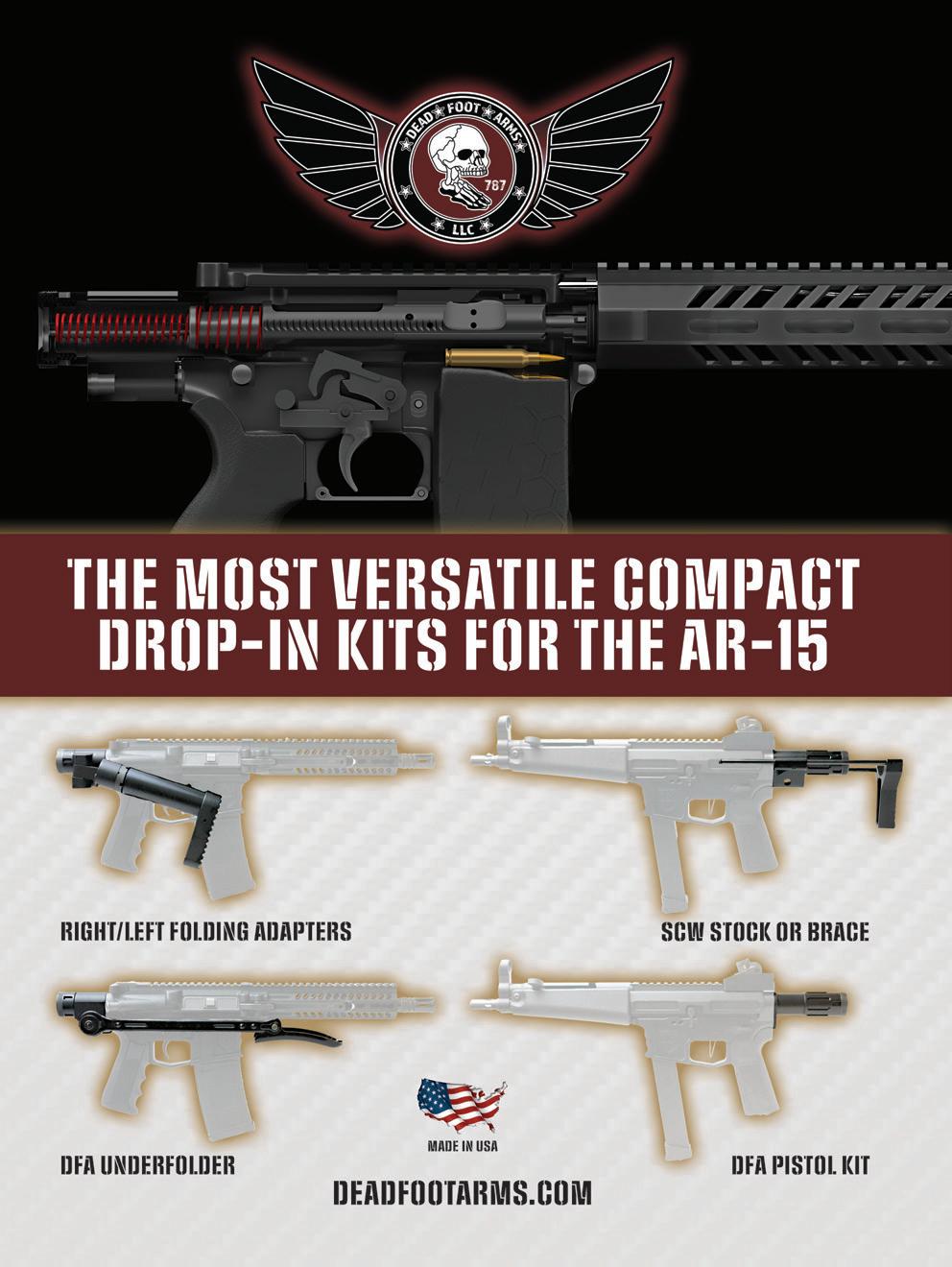
TACTICAL TRAINING
Finally, the selection for the role is unsatisfactory. Everyone in a squad has a job or two. Many times, the role will be assigned to the best shooter in the squad based on qualification scores. While there is merit in this, it is not the way. As a former senior noncommissioned officer, I do not want my squad or team leaders focusing on a single target to eliminate. They need to be leading, as their title implies. Obviously, the machine gunner and the grenadier have jobs to do too. This leaves the rifleman, the newest person to the squad, with the space to do the job. Odds of this being your best shooter are low, but it is their job to shoot whatever the squad leader tells them to. Thus, the wrong person gets selected for the job. The follow-on to this is that by the time someone gets to the level of being a good DM, they are promoted away from the role.
MY MENTOR ONCE told me to not mention problems without a proposed solution.
So here are my thoughts on DM fixes. Onboard every new member of the force with DM training. This should include complex engagements, ballistics, stability and environmental effects. This would effectively train all members of the unit in these skills and over time the effectiveness of the squad would increase. Imagine having 10 DMs versus one. One, though, has the rifle for it. This also adds redundancy because rather than a single point of failure, anyone can grab the DM rifle and do excellent work. Next, training for all should go out to 600 meters or yards. Then and only then will leaders know who is good. It does not have to be often, but it needs to be done. This profoundly changes the squad dynamic, the role and use of the DM, and has the added benefit of becoming a feeder for sniper sections.
While this article focuses on military application, it can apply to law enforcement. The DM role might be as close as 100 yards, but the rules
still apply. The odds of the trained officer being on the scene to do a lowprobability hit are low. But if all officers have the basic skill set, equipment and understanding, those odds of someone being on the scene to make that shot are exponentially higher.
No, the DM will not save everyone. The DM is not a fix. A good foundation in marksmanship beyond typical engagement ranges for all members of the force will change gunfights in favor of the good guys.
Editor’s note: Ash Hess is a highly seasoned combat veteran of 22 years with four combat deployments to Afghanistan and Iraq, totaling 52 months. His military training includes the US Army Master Marksman Trainer course, as well as rifle marksman instructor, urban combat leaders’, senior leaders’, army basic instructor, high-angle marksman and unit armor courses. He also wrote TC322.9, the Army’s marksmanship manual.



46 American Shooting Journal // April 2024



The FG-15 is just a grip when not in use, when the handle is deployed it is a trigger crank, allowing you to fire one shot per 120 degrees you crank the handle.
The FG-15 has been tested on a 20 year old Bushmaster, new Aero Precision, Daniel Defenses, LWRC, Ruger, Bravo Co, to name a few. Aside from the twin stainless Japanese precision ball bearings, the FG-15 is an American made and seriously overbuilt piece of kit. Comprising of nitride 4140 steel machined components, hardened S7 trigger striker pin, and many more high quality components. The FG-15 was mechanically tested for over 1,000,000 shots fired. At that point, the components showed only a light surface finish wear.
In the prone and with your weapon on a bipod, it allows the user to consistently put shots on target without trigger fatigue. Any AR-15 type firearm that has a 1/4-28 thread pitch for the grip screw will accept the FG-15 grip. Which is 99% of AR-15 lower receivers.

THE THIS PRODUCT CAN’T BE SHIPPED TO THE FOLLOWING STATES CA, CO, CT, DE, FL, HI, IL, IA, MD, MA, MN, NJ, NY, RI, VA, WA, DC GET IT NOW AT freedomordnance.com WITH NO PERMANENT MODIFICATION TO YOUR FIREARM EASY INSTALLATION TO YOUR FACTORY TRIGGER FULL
AND
BALL BEARING
HIGH
ORDNANCE
HEAT
FINISH
FG-15 TRIGGER ACTUATING GRIP
USE
ACCESS
EQUIPPED CRANKHANDLE
QUALITY
GRADE STEEL COMPONENTS
TREATED
ON STEEL PARTS QPQ NITRIDE WORKS WITH MOST AR TRIGGERS STANDARD AR/SR PATTERN GRIP


HOW EXECUTIVE PROTECTION TRAINING HAS CHANGED OVER TIME
At ESI, long gone is evasive driving in favor of intelligence-based intervention skills.
STORY AND PHOTOS BY GRACIELA CASILLAS
magine a world where a corporate executive’s safety is often shadowed by potential threats. In this high-stakes environment, one firm emerges as the leader in protection. Executive Security International, or ESI, is often hailed as the Harvard of executive protection. With over four decades of setting the highest standard in the field, and guided by the visionary leadership of Bob Duggan, ESI epitomizes excellence. As someone deeply

Iembedded in the security industry, I’ve directly experienced the unique training and expertise that ESI delivers.
I first met Duggan in the 1970s when he served as my martial arts instructor in hwa rang do. In 1980, I participated in the initial 10-Day ESI Executive Protection course. More recently, I once again completed the course, which is now 28 days, and was struck by the profound metamorphosis the program has undergone since my initial encounter over four decades ago.
Initially, the training emphasized reactionary skills: escape and evasive driving, defensive shooting, martial
arts and Secret Service protocols. Duggan brought in renowned figures like race car driver Wally Dallenbach and shooting instructors Lance Weber, Dick Barber and John Farnam to impart specialized knowledge. However, feedback from ESI graduates in subsequent decades highlighted a gap between training and realworld application. The adrenalinefueled driving maneuvers taught by Dallenbach in the 1980s – ramming, forward and reverse 180s, high-speed takeout counter-maneuvers on the highway – were rarely employed while on duty in corporate settings.
americanshootingjournal.com 49 TACTICAL TRAINING
Bob Duggan, who founded Executive Security International in 1980, demonstrates a gun-removing maneuver. Over the decades, Duggan has tweaked his training to better represent real-world situations bodyguards need to protect against.


While protective formations are useful in dense crowds and with unruly fans, they are seldom used in corporate environments or for celebrities not performing for an audience. It was more typical to be a solo practitioner or perhaps work in a team of two. As much as they valued the shooting skills learned on the shooting range, they never heard of a gunfight between protective details and the bad guys anywhere. The reports from working graduates were impactful, causing Duggan to reevaluate teaching methodologies and revamp ESI’s teaching philosophy.
DUGGAN INTRODUCED THE stalker program in place of the evasive driving course. With this came the shift from reactive skills to intelligence-based close protection, or IBCP. The transformation extended beyond theoretical frameworks to practical applications, with an emphasis on engaging individuals in interrogative conversations as a means of preemptive intervention.
This shift towards a more holistic approach to protection, encompassing both physical and intellectual facets, reshaped ESI’s training philosophy.
According to Duggan, identifying abnormal behavior in the crowd –targeting the precursors to assault – is as important as how fast you draw and fire your gun. These are two different skill sets, both relevant to the professional protector – one reactive and the other preemptive. Observing and preempting ambiguous aggressive behavior begins with developing critical thinking skills. While most testosterone-driven young men and women may not embrace the concept or the need to develop behavioral intelligence, the reality is that most will never find themselves in a physical confrontation that requires the use of lethal force. According to Duggan, there is a critical difference between protective escorts and intelligencebased close protection. He argues that failure to identify the precursors to the attack, whether deadly or prank,
equates to certain failure.
Duggan explained that his shift in thinking began in the mid-1980s when Ed Bradley from 60 Minutes was filming a segment on ESI. Knowing Duggan’s interest in the subject of deadly assaults, the director of the production crew offered to share the CBS archive on assassinations. Duggan was excited at the offer of documentation of his favorite subject, the discreet details of targeted hits. So he continued building his collection of documentary clips of attacks on public figures worldwide. His collector’s obsession grew into a library of scores of films that he now uses in class.
But to Duggan’s astonishment, there wasn’t a single example of a successful intervention, whether a deadly assault or a prank, which, in Europe and here in the US, is a popular way to embarrass public figures. No one leaped in front of the bullet or intercepted the hand of a flourbomber – not once! Duggan found comfort in his discovery that several

TACTICAL TRAINING 50 American Shooting Journal // April 2024
Duggan teaching a class. ESI has its campus in Grand Junction, Colorado, on the west slope of the Rocky Mountains.





BEGIN YOUR CAREER IN EXECUTIVE PROTECTION OR CORPORATE SECURITY TODAY.
TACTICAL TRAINING
federal agencies or their working agents used the same strategy. For example, he learned that the Drug Enforcement Administration used the technique with astonishing results: an 85-percent success rate in identifying, engaging and arresting drug couriers in international airports in the 1970s. Following the 9/11 attack on the country, the Transportation Security Administration learned the methodology from the Israelis to preemptively interview airline passengers.
AFTER STUDYING SCORES of assaults on public figures, Duggan refocused ESI training by including behavioral intelligence as the basis of preemptive intervention. Statistically, deadly assaults on public figures like corporate executives are extremely rare, and gunfights between protective details and assassins don’t happen – and haven’t happened anywhere on the globe. More discouraging data is that protective details have failed to prevent lethal attacks on public figures – shockingly – 100 percent of the time. There isn’t a single example of a protection detail or solo practitioner who reacted in time to save their client from harm by an up-close deadly assault as far back as we have recorded history.


Duggan points out that most protection training focuses on physical components of training and combative skills. Yet today, clients are looking for practitioners who are sophisticated with valuable skills worth paying for and often have nothing to do with combat skills.
ESI’s evolution in approach paralleled developments in federal agencies and military tactics, with
concepts such as “Identify-EngageAct” finding resonance in the Combat Hunter course adopted by the US Marine Corps. Collaborations with individuals like Meb and Jenny West, who have extensive backgrounds in military intelligence, enriched ESI’s curriculum, emphasizing the importance of threat assessment and management at a corporate level.
Duggan used the phrase “searching
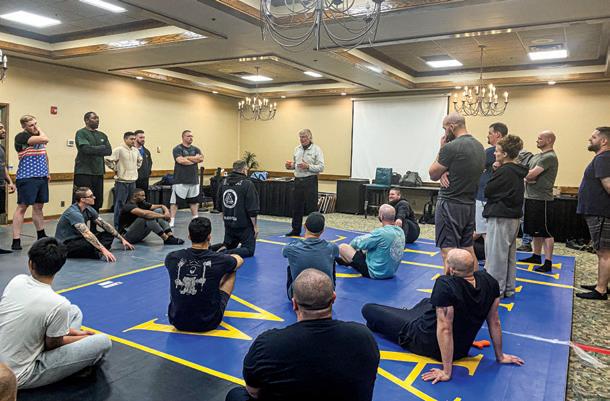
52 American Shooting Journal // April 2024
Keith Buckner, ESI range master, instructs on the firing line.
Students practice gun-removing techniques. Duggan addresses a class before a training session.

for the precursors to assault,” while the Marine Corps spoke with more precise language: “Hunt!” Duggan conceded that the corps’ language was more direct and translatable into action than what he taught. A significant difference existed between the search methodology of a corpsman and a protector. A corpsman looks down the sights of his M-4 at 100 yards, while the protection agent is focused on the threat generally at 20 feet or less, and if he does his job right, he seeks out the predator in the crowd like a laser beam at arm’s length. ESI adopted “predator hunting,” approximating the Marine Corps’ targeted language.
A crucial component to the predator hunter concept is to require that students know how to engage the person of interest, or POI. It is not enough to have your “head on a swivel” or have “situational awareness.” None of these commonly used terms by protection agents adequately deal with the “hunter complex,” which requires making direct contact and engaging the POI in an interrogating conversation. Two of the three critical components of hunting are engage and act. Duggan teaches these concepts in terms of a soft or hard entry. When you go in soft, you must have a conversational skill set and team backup if the contact goes south.
AS SOMEONE WHO has traversed both


the training and operational field of executive protection, I’ve witnessed firsthand the impact of this paradigm shift. The modern close protection specialist is no longer defined solely by physical prowess but by their ability to anticipate and mitigate potential threats through informed decisionmaking.
Reflecting on my own journey, I am reminded of the invaluable lessons gleaned from ESI’s Executive Protection program. The rigorous curriculum challenged not just physical abilities, but also fostered critical thinking and situational awareness, essential attributes for navigating the complexities of the field. The importance of developing our mind and intellect was emphasized. The course was challenging and not every student made it to the finish line.
After completing the course, I understood why ESI is referred to as the Harvard of executive protection. Duggan is a visionary and inspiration to students. His philosophy permeates throughout the ESI curriculum, establishing higher standards in the field and elevating executive protection
to an elite level, shaping a new generation of world-class practitioners.
In conclusion, the evolution of ESI’s training philosophy underscores the dynamic nature of the field of executive protection. By embracing a holistic approach that integrates behavioral intelligence with traditional defensive tactics, ESI has positioned itself at the forefront of executive protection training, empowering practitioners to adapt and excel in an ever-changing landscape.
Editor’s note: Author Graciela Casillas is a certified personal protection specialist who works as a staff instructor with Executive Security International bodyguard school (esibodyguardschool.com). She is also an advanced firearms trainer and has worked with many world-class firearms instructors. She has authored many articles on the subject for various publications and holds a bachelor’s degree in law and society, master’s degrees in education and physical education, and lifetime teaching credentials in psychology.
TACTICAL
54 American Shooting Journal // April 2024
TRAINING
Three shooters smile after finishing top of their particular class.
Author Graciela Casillas, Buckner and Duggan after a successful class.





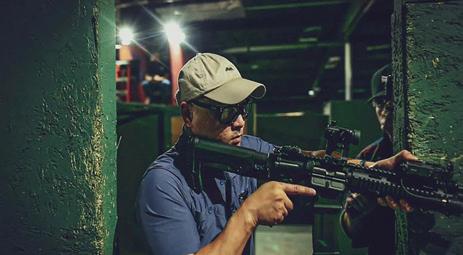



americanshootingjournal.com 55 we bridge the gap between warriors and everyday heroes sawmillttc.com 8524 Neely Ferry Rd, Laurens SC 29360 Elite Training for Specialized Forces Empowering Civilians: Resilience and Preparedness


WHY MANDATING FIREARM SAFETY TRAINING IS A GOOD THING
Arguments include saving lives, reducing crime rates and keeping lawful gun owners safe.
STORY BY JASON BROOKS
s many readers may know, on October 21, 2021, there was an incident on the film set of Rust at the Bonanza Creek Ranch in Bonanza City, New Mexico. Cinematographer Halyna Hutchins was fatally shot and director Joel Souza was injured when a live round was discharged from a revolver used as a prop by actor Alec Baldwin. A jury later found Hannah

AGutierrez-Reed, the armorer on the set, guilty of involuntary manslaughter.
But if Baldwin had taken a firearm safety class, he would not have shot and killed his coworker if he applied the fundamentals of firearm safety. Universal firearm safety rules can be found in any Google search. The first rule is to “treat every weapon as if it were loaded.” This means if a firearm is handed to an individual or if that person picks up the firearm directly off a table, they should always treat it like a loaded weapon. A self-check will determine if the weapon
is indeed loaded, and clearing the weapon or unloading the firearm in a safe manner would be the next move to ensure the firearm is safe. Had Baldwin followed that one simple rule, a life could have been saved. Mandatory firearm safety training will reduce accidents, keep lawful firearm owners safe and reduce crime rates.
A LACK OF firearm training is dangerous. Only about two-thirds of gun owners have attended any type of safety training, which means there are
americanshootingjournal.com 57
TACTICAL TRAINING
Mandatory safety training around universal firearm handling rules would benefit first-time handgun owners and ultimately society at large, argues author Jason Brooks. (SHUTTERSTOCK)

roughly 26 million legal gun owners who are not trained properly on how to use the firearm they purchased. One in seven firearm owners has received some training in suicide prevention (firearms are the most used medium in youth suicides). This issue needs to be addressed so that when someone purchases a firearm, they are made aware of the statistics.
People who purchase a firearm for self-defense are less likely to receive safety training than people who purchase a firearm for hunting or sporting reasons. This is problematic because there are an estimated 1.67 million self-defense incidents involving firearms every year, per a 2021 national
survey, with handguns being used over 65 percent of the time. This lack of training leads to more accidental shootings, and not knowing how or when to use your firearm properly will end up costing legal gun owners more than just money – it could cost a life.
Firearm safety training saves lives. Safer firearm storage could prevent many youth firearm deaths due to suicide and accidents. Learning to store a firearm properly is part of firearm safety training, which many people are unaware of. Since 2013, there have been well over 15,000 unintentional shootings in America. This means that whoever was holding the firearm at the time did not respect
the basic safety rules of firearms.
In contrast, if a person wants to go skydiving, mandatory safety training and rules must be learned and followed. To obtain a driver’s license, an individual needs to pass a vision, knowledge and skills test just to legally drive a car. Even at some gun ranges, a person must complete a mandatory class on safety rules and sign a waiver before using the range. Why not use the same philosophy of safety when an individual purchases a firearm for the first time? Adherence to firearm safety rules would eliminate accidental shootings.
Legal ownership of firearms reduces crime. Over 31 percent of gun owners, or approximately 25 million adult
TACTICAL
58 American Shooting Journal // April 2024
TRAINING
Where hunters and shooters typically receive some degree of safety training, those who buy a firearm for self-defense are less likely to, raising the risk of accidental shooting and even death. (SHUTTERSTOCK)
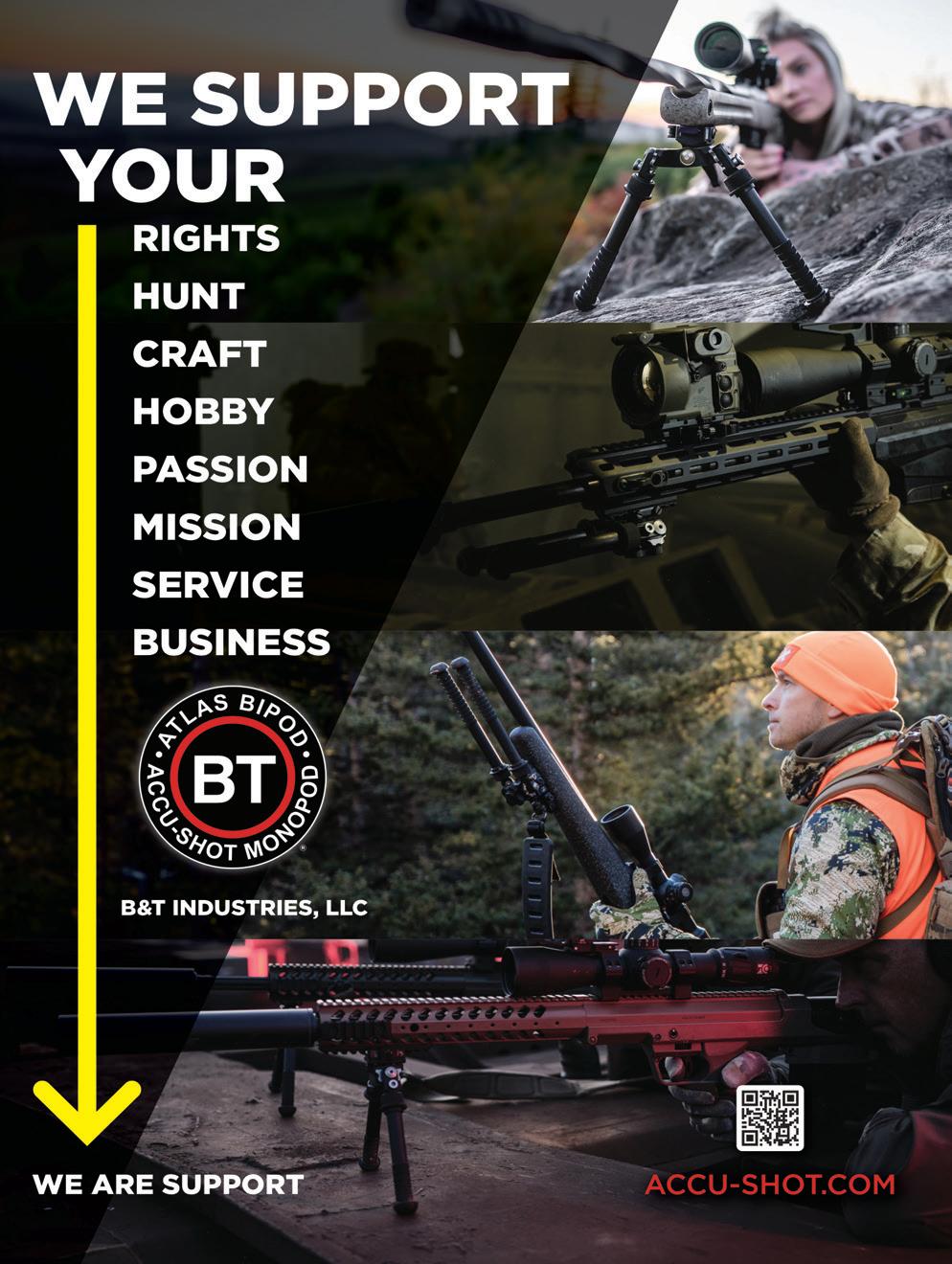
Americans, have used a gun in selfdefense. Murder and robbery declined by 20 percent and 13 percent, respectively, in areas with strong gun laws. Criminals tend to move across communities more readily in response to changes in concealed handgun laws rather than in response to changes in arrest rates, which proves concealed handguns deter criminals. A US Department of Justice study of convicted felons determined that criminals are indeed afraid of armed citizens. When a criminal realizes a person is armed, they will go find another victim who is an easier target. Criminals fear armed citizens more than they fear police officers.
MANDATING TRAINING FOR all first-time gun owners will save lives, reduce crime rates and keep lawful firearm owners safe. Applying universal firearm safety rules, along with the supporting training and knowledge on all things related to firearms, will positively
impact our country. Law-abiding firearm owners will help reduce crime and keep communities safe.
Firearm safety is not just a phrase but a way of life. Respecting all aspects of legal firearm ownership should be a priority for all firearm owners. From carrying a firearm to storing one, a conscious effort should be made to be as safe as possible.
As a reminder, always remember these handgun safety rules:
1) Always treat all weapons as if they are loaded. Make sure unloaded weapons are checked and rechecked; visually and physically inspect weapons, ensuring the weapon you are inspecting is pointed in a safe direction.
2) Never be careless when handling a firearm. Never allow the muzzle to cross anything you are not prepared to destroy, and never have the weapon out while people are forward of the line.
3) Keep your finger off the trigger
until your sights are on target and you have made the conscious decision to shoot. Simply keep your finger off the trigger until the gun needs to go bang; if you’re not making the gun go bang, finger stays off the trigger.
4) Be sure of your target and what is beyond/adjacent to the target. If you cannot identify what you are shooting at, then don’t shoot at anything at all.
For more information about firearm training, contact a local firearm trainer. Seek out the finest qualified instructor with a sound, reputable background. ★
Editor’s note: Jason Brooks is a combat medically retired marine, force recon hand-to-hand instructor, counterterrorism instructor trainer, recognized national law enforcement trainer, active personal protection specialist and co-owner of Assault Counter Tactics. Visit assaultcountertactics.com for more.

60 American Shooting Journal // April 2024
TACTICAL TRAINING

Noteworthy & New-ish Wheel Guns
A
 STORY BY FRANK JARDIM
closer look at Colt's Anaconda and King Cobra Target .22 LR, Korth's NXS 8 and Mongoose, Kimber's K6XS and K6S, and Taurus's Judge Home Defender.
STORY BY FRANK JARDIM
closer look at Colt's Anaconda and King Cobra Target .22 LR, Korth's NXS 8 and Mongoose, Kimber's K6XS and K6S, and Taurus's Judge Home Defender.

As a gun writer, I get the opportunity to shoot lots of guns. It’s one of the perks of the job. In the last year, my experience with revolvers from Colt, Nighthawk, Kimber and Taurus were especially noteworthy. The models I’ll share with you here span price points from value to luxury, but what they all have in common is engineering that makes them stand out from the crowd. These revolvers demonstrate that there’s still room for technical evolution in the 160-year-old double-action platform.
americanshootingjournal.com 63
Korth NXS. (NIGHTHAWK CUSTOM)
COLT
Colt’s Manufacturing fathered the revolver and remained one of the world’s largest producers of doubleaction revolvers until police agencies basically abandoned wheel guns for autoloaders in the 1980s. In the last decade, Colt made a strategic decision to get back their revolver business and in 2017 began reintroducing their always-popular snake guns with some genuine and important modern improvements.


Though it can be hard for lovers of old Colts to accept, the new Pythons and Anacondas are better by virtue of their excellent double-action trigger pulls that are lighter and smoother than the ones that rival Smith & Wesson was long famous for. Colt redesigned their lockwork, shifted the trigger farther forward, eliminated the stacking and shortened the stroke to make one of the best double-action triggers in the world. New and more efficient manufacturing procedures also kept retail prices reasonable for the high quality. The mirror-like, “semi-bright” finished stainless steel guns are breathtaking. Examining and shooting them, I concluded they are the highest-quality production revolvers on the market.
Anaconda Colt’s new .44 Magnum is a close visual match for its 1990 predecessor, except for the trigger
position, transfer bar safety, heavier frame, adjustable rear sight that can be swapped out for a Picatinny rail, and the slightly lengthened cylinder intended to accommodate longer than standardlength hunting ammunition loaded with heavy-for-caliber bullets like the Hornady Custom 300-grain XTP.
It comes with a Colt logo Hogue rubber overmold grip, but the actual grip frame is scaled to accept Pythonsized grips. The double-action trigger pull is a smooth 9.2 pounds, and single-action a crisp 5.25 pounds. The 8-, 6- and 4.25-inch barrel lengths all feature a matted top to minimize reflections along the sight path, and recessed crowns to protect the muzzle. This is the highest-quality production .44 Magnum double-action revolver available today. MSRP: $1,499.
King Cobra Target .22 LR Introduced in 1986, the original King Cobra was a
hefty .357 Magnum based off the Colt Trooper and featured a full underlug barrel. Colt’s new Cobra frame is completely different and serves as the starting point for several full underlug barrel, six-shot, snubnose, carry and target models in .38 Special+P, .357 Magnum, and a delightful 10-shot .22 LR target model in 4.25- and 6-inch barrel lengths.
The .22 LR has a ventilated rib, fiber-optic front sight, adjustable rear sight and Colt logo Hogue rubber overmold grip. Trigger pull weight is 9.75 pounds in double-action and 3.5 pounds single-action. Minimal recoil, report and muzzle blast, combined with a smooth double-action, make this pistol worthy of consideration for self-defense. A shooter could unleash 10 shots in 2.39 seconds, presenting an attacker with a swarm of lethal angry bees. MSRP: $999.
Visit colt.com for more.
64 American Shooting Journal // April 2024
Colt Anaconda. (COLT)
Colt King Cobra. (COLT)

KORTH
Korth revolvers have been known worldwide since the mid-1950s for their unrivaled quality and craftsmanship. They are to revolvers what Nighthawk Custom is to 1911 platform pistols. Nighthawk became the exclusive importer and distributor of Korth revolvers in 2016. The two gunmakers share similar manufacturing philosophies and goals for top-tier excellence, so their partnership is a natural fit.
Nighthawk Custom built their reputation for top-quality custom 1911 platform pistols with the “One Gun. One Gunsmith” approach that maintains quality control through complete accountability at every step in the building process. Their guns are built one at a time by a single highly skilled artisan who perfectly hand-fits the purposely oversized parts, finishes and then tests his gun. Korth revolvers require less hand-fitting since the parts
are not made purposely oversized, but instead held to absurdly tight tolerances in production. Each Korth is custom-ordered and hand-built for the individual customer and delivered capable of exceptional accuracy and several lifetimes of heavy use.
Nighthawk’s website has details on 14 different .357 Magnum/.38 Special and .44 Magnum Korth models for sporting and tactical purposes covering concealed carry, target shooting, hunting and competition. Korth’s signature features include push-button cylinder removal, optional 9mm cylinders for their .357 Magnum guns, a push-forward cylinder release lever next to the hammer, and a twopiece barrel design consisting of a hammer-forged rifled inner sleeve surrounded by a separate shroud. The front of the shroud also serves as a mounting point for Korth’s optional recoil compensators, which greatly enhance control in rapid fire.
NXS 8 .357 Magnum
This is Korth’s first eight-shot revolver built as a tactical or competition gun with integral Picatinny rail on the top of the frame, windage and elevation adjustable rear sight, and a ventilated barrel shroud with removable front sight protectors and upper and lower Picatinny rails. The steel finish is a black Diamond Like Carbon (DLC) with contrasting bright trigger, hammer, barrel sleeve and ejector rod. Ample finger groove grips of Turkish walnut help manage recoil. Available in 4- and 6-inch barrel lengths. The cylinder is cut for fastloading moon clips, but Korth also makes eight-shot speedloaders of milled aluminum. MSRP: $5,199 for 4-inch barrel; $5,299 for 6-inch barrel.

Mongoose .357 Magnum
More conventional in appearance, this six-shot has no Picatinny rail. The barrel shroud has a full underlug
 Korth Mongoose. (NIGHTHAWK CUSTOM)
Korth NXS. (NIGHTHAWK CUSTOM)
Korth Mongoose. (NIGHTHAWK CUSTOM)
Korth NXS. (NIGHTHAWK CUSTOM)


and ventilated top rib. Barrel options include 2.75-, 3-, 4-, 5.25- and 6-inch lengths. It has a fully adjustable rear sight and a 14k gold-dot-enhanced front sight blade. The steel is finished in black DLC with contrasting bright trigger, hammer, barrel sleeve and ejector rod. Recoil-absorbing Hogue finger groove black rubber overmold grips come standard. MSRP: $3,699. See nighthawkcustom.com for more.
KIMBER
In the 30 years since Kimber started making guns, they’ve designed and built some extraordinary rifles and handguns, and earned a reputation for creative innovation and affordable high quality. One of their most impressive accomplishments is the unique K6S revolver line, featuring a
smooth, nonstacking, double-action trigger pull that is both shorter and generally a couple pounds lighter than S&W production guns. The K6S revolvers have double-action pull weights from 9.5 to 11.5 pounds, which Kimber achieves without any hand-fitting, relying instead on the tight manufacturing tolerances of their parts. As a result, the double-action trigger pull of the K6S is one of the easiest to master.
Kimber revolvers are made in 2-, 3- and 4-inch barrel lengths in concealed carry double-action-only and conventional double-action/ single-action models. All have radiused sculpted edges to reduce printing through clothing, six-shot cylinders with recessed chambers, underlug barrels, shrouded ejector rods that
provide a second indexing point for the cylinder, and a checkered but nonsnagging, press-in-to-release cylinder latch. With a 2-inch barrel, Kimber’s all-stainless-steel K6S is the lightest six-shot .357 Magnum in production at 23 ounces.
K6XS Ultra-Lightweight .38 Special+P Snubnose This concealed hammer, double-action-only snubnose is Kimber’s lightest. To reduce overall weight from 23 to 15.9 ounces for easier carry, Kimber used an aluminum alloy frame with a fixed rear sight, lightened the stainless steel barrel by cutting a window through the side of the ejector shroud, and lightened the stainless steel cylinder by cutting the flutes deeper. The tradeoff for the aluminum frame was limiting the caliber to .38 Special+P. The pistol wears a silver KimPro II finish on the frame and a glass-bead finish on the 2-inch barrel, cylinder and crane.
The combination of an excellent double-action trigger pull and the Hogue rubber, cobblestone-texture, finger groove grip allowed me to do some impressively accurate shooting with this snubnose. I rate it as the best of its class. MSRP: $679.
66 American Shooting Journal // April 2024
Kimber K6S. (KIMBER)
Kimber K6XS. (KIMBER)


K6S (DASA) 2 Inch .357 Magnum
Snubnose For those who want the lightest, full stainless steel, six-shot, exposed hammer, double-action/ single-action concealed carry gun that can handle full-power magnum loads – at 23 ounces – this is it! This model has three-dot sights. The front is pinned on and the rear dovetailed to the frame, allowing for some windage adjustment by drifting. Like all the DASA models, the singleaction trigger pull ranges from 3.25 to 4.25 pounds. The metal wears a matte brushed stainless finish, with a grooved backstrap. The checkered walnut grips are smaller than those on the K6XS, trading some control and recoil mitigation for better concealability. MSRP: $1,194. Check out kimberamerica.com.
TAURUS
Back in 2006, when Taurus was just introducing the massive Judge dualcaliber revolver chambered in .45
Colt and .410 shotgun, I remember thinking that there was probably a good reason that I couldn’t recall any combination revolver/shotguns after the cap-and-ball Lemat revolver of Civil War fame. Where I was a bit skeptical of the concept, Taurus correctly deduced that the time was right and has been making the Judge in various forms like crazy ever since. S&W even copied them.
Judge Home Defender .45 Colt/.410
The new Judge Home Defender has a soft rubber checkered pistol grip, a 13-inch barrel with a long, riflestyle checkered forend in hard black polymer, and a built-in shield around the bottom of the cylinder to protect you from the gases escaping through the cylinder gap. It has no iron sights. Instead, the frame is topped with a Picatinny rail for mounting a red dot optic. There’s another section of Picatinny rail on the bottom front of the forend to mount a combination
tactical light and targeting laser. Equipped in this manner, even your frail grandma can repel boarders from the deck of a man-o’-war.
While you could shoot the Judge Home Defender with one hand, it works better with a two-hand hold. Recoil, even in rapid fire, is easily managed with two hands, especially if one shoots with the gun locked against the hip and targets with the laser. In that case, you can unload the five-round cylinder into your target in 1.17 seconds. A lot of people, especially those with limited upper body strength, might be hard-pressed to get one round off and chamber the second with a pump shotgun in that time. Made of alloy steel with a black matte nitride finish, it measures a handy 19.5 inches overall and weighs 58.6 ounces. The cylinder accepts 3-inch shells, which allows the use of a wide range of specialized defensive loads. MSRP: $729.
Go to taurususa.com for more. ★
68 American Shooting Journal // April 2024
Taurus Judge Home Defender. (TAURUS)


L.E. SPOTLIGHT
PRAISE FOR THE DISPATCHERS
They’re the vital link between the public and law enforcement, directing help to where it’s needed asap.
STORY BY NICK PERNA • PHOTO COURTESY OF REDWOOD CITY POLICE DEPARTMENT
hey are the unsung heroes of the law enforcement community. Their work rarely takes them outside the police station, but they have as much, if not more, interaction with the community than do the officers on the street. They are the first link in the law enforcement chain, receiving the initial notification of the need for a police response.

TThey are part telephone operator, directing people where to go for services they need. They are also part supervisor, receiving calls from persons in distress and in need of assistance, determining what type of response is required. They are part detective, listening for clues when taking calls. Finally, they are part counselor, providing aid and advice to those who need it.
Of course I’m talking about dispatchers, the voice on the other end of the line who takes the call and determines what is needed to solve the problem. They operate in a difficult, almost two-dimensional world, where almost all of their interactions with victims, suspects, witnesses, reporting parties, officers, firefighters, EMS and so on are either over the phone or by radio. In comparison, in law enforcement, officers in the field have the advantage of being able to see who they are talking to and to view the situation in question. It is much easier to put the puzzle together when you have all of the pieces.
Dispatchers deal with the same stressors that police officers face. Like cops, they have to make split-second decisions that literally can mean the

“Like cops, (dispatchers) have to make split-second decisions that literally can mean the difference between life and death,” says author Nick Perna. Pictured is Rolanda Miles, a dispatcher for the Redwood City Police Department in Northern California, who was working the night Perna’s partner was shot. The dispatchers calmly and quickly got the officer the aid he needed and he survived.
difference between life and death. They knowingly send officers into harm’s way, realizing the full ramifications of this. I have no doubt that if it wasn’t for some of the great work done by dispatchers I’ve worked with, I probably wouldn’t be around to write this article today.
Dispatchers are forced to listen to the same putrid, vile stuff that entitled people say to cops on the street. Other than the physical dangers, the job of dispatcher and the job of police officer are very much alike. They are overworked, underpaid and work the same crappy hours that cops do. They suffer from PTSD and have shorter life spans than their counterparts outside the field of public safety.
TAKE FOR EXAMPLE the efforts of Chicago Police Department dispatcher Keith Thornton Jr. While working on August 7, 2022, he took the call everyone dreads – officer down. Two CPD officers had been shot. One officer, Ella French, would later succumb to her
wounds. Thornton Jr. was essential in directing responding officers, including redirecting them to a trauma center when they initially opted to go to a general hospital. He talked officers through the process of treating the wounded officers, advising them to remove their body armor and to do CPR.
I was involved in an incident many years ago where my partner was shot (he survived). Once the dust had settled, I got to listen to the recordings of the dispatchers who were on the call that evening. It was amazing to listen to how calm they were as they worked through the problem, getting my partner the aid he needed, coordinating other resources and taking calls from reporting parties, along with dozens of other tasks.
I’ve had the honor of working with some great dispatchers in my career. I’ve listened to them maintain their calm, professional demeanor as cops yelled unintelligible things into the radio during use-of-force incidents, foot
americanshootingjournal.com 71

chases and vehicle pursuits. I’ve “solved” more than one case when I got a call from a dispatcher who’d put on his or her Sherlock Holmes hat and did extra research using one of the seemingly endless array of databases they’re trained to access.
It’s the little things that set them apart too. They often play the part of concerned parent, especially for younger officers. As part of a daily routine, officers are required to log on, letting dispatch know they are working and available. Often, we forget to log off and go out of service. On more than one occasion, I’ve had a dispatcher call me well after my shift to make sure I’m done for the day. This is done in part to be thorough, knowing what resources (officers) are available to respond to calls. It goes much farther than that, though. Good dispatchers take the care and well-being of their officers seriously, so I know those after-shift phone calls were more about making sure I made it home OK.
So here’s to the dispatchers – the first link in the public safety chain and the voice of the department.
Editor’s note: Author Nick Perna is a sergeant with the Redwood City Police Department in Northern California. He previously served as a paratrooper in the US Army and is a veteran of Operation Iraqi Freedom. He also has a master’s degree from the University of San Francisco. He is a frequent contributor to multiple print and online forums on topics related to law enforcement, firearms, tactics and veterans issues.

72 American Shooting Journal // April 2024


74 American Shooting Journal // April 2024

SCATTERGUN ALLEY HITS, MISSES, AND RED DOTS
Mounting an optic on your turkey shotgun will make you a sharper shooter, and here are a few different brands to look at, er, through.
Sitting in his favorite booth at the Pine Top, my buddy seemed very distracted. He was chopping away at his plate of biscuits and gravy, two hen eggs over grits and home fries, with lots of black coffee. Just like the booth, this was his favorite breakfast, but it was obvious he wasn’t enjoying it today. To be nice, I offered a sympathetic, “What the hell is wrong with you?” But I already knew the answer.

Earlier that morning he had missed a turkey.
To many turkey hunters, you see, this is a horrendous event that may stay with them for years. There is often a tremendous amount of work and worry in getting up close and personal with a wary old reprobate gobbler. All of that hiking and climbing and sweating and sneaking and sometimes crawling. (Gad! I hate the crawling!) And then to suffer a miss, well, some of us are scarred for life. I thought of all this as I watched him flailing on his breakfast, and pondered what can be done to prevent this lifealtering event from happening to you. (Of course, I was feeling very highminded about all this because I had not missed a turkey that day.)
PATTERN YOUR SHOTGUN
For about the 20th time, for heaven’s sake, pattern your shotgun before
season starts. I don’t really know how many times we have gone over this in our little sessions here, but this is important. Some of us will spend a great deal of time before deer season making sure our rifle is carefully sighted in. We may take multiple trips to the range to make absolutely sure our deer slayer is shooting dime-sized groups at 300 yards. This is all well and good – you should do this – but for some reason many of us don’t even think about spending an hour or two at the range to do the same with our scattergun. For reasons known only in heaven, many turkey hunters grab the shotgun out of the closet on opening morning, throw it in the truck and head to the woods.
Here is a newsflash for you, in case you don’t know (many of you do), but a shotgun is not a precise weapon. Please go back and read that sentence again. The pattern of pellets coming from your shotgun barrel will not necessarily land in the same place on the target every time. With the same gun, choke and ammo, it will stay relatively close, but not 100 times out of 100.
Testing your shotgun will first determine where the gun is shooting in general. Shotguns, you see, do not all shoot where they look, meaning there is a point of aim (POA) and a point of impact (POI). At, say, 35 yards, you aim at a place on your target paper (the POA) and when you shoot, the pattern may appear in a nice cluster around
americanshootingjournal.com 75
STORY BY LARRY CASE
The Burris SpeedBead Vent Rib Mount is compatible with FastFire and other red dot optic systems. (BURRIS)

the POA. But it may just as easily hit high and to the left of your POA, or low and off to the right or whatever. If this happens, you need to take steps to correct this, but at least you know now there is a problem. You would not have known this if you didn’t do the testing on paper.
GO FOR THE RED DOT
In simple terms, a red dot sight projects a red dot onto a glass lens, allowing for quick and easy target acquisition. Unlike traditional iron sights, which require aligning front and rear sights, a red dot sight greatly simplifies aiming. Red dot sights are commonly used for short ranges typically 100 yards or less (perfect for shotguns).
If your POA and your POI are not the same, installing an optic on your shotgun will take care of this, as now
you can “sight in” your shotgun much like you do your deer rifle. Red dot sights have become the rage for pistols and turkey shotguns for one big reason – they work! With the optic properly mounted on the receiver or the rib of the shotgun, you can sit down on a shooting bench and shoot a few rounds and dial the pattern in.
Here is another big reason to go with a red dot type of optic on your shotgun. We have talked here before about how in the scenario of calling in turkeys, we are “aiming” the shotgun at a hopefully stationary target: the head and neck of a gobbler. We are not shooting the shotgun in the classic manner of swinging on a flying target. We are aiming as we do with a rifle.
RED DOT OPTIONS
Remember, many red dot offerings
are often touted for use on handguns, especially the micro models, but that doesn’t mean you can’t put them on a shotgun. The first thing we must do is mount the red dot optic securely on the shotgun, and one good way to do that is with the Burris SpeedBead Vent Rib Mount. The SpeedBead is great for updating any shotgun that did not come from the factory with an opticcompatible receiver. This is an ideal solution not only for shotguns utilizing high-density ammunition, but also for shotguns fitted with tight chokes or for hunting styles that bring big toms into close range. Designed for use with the Burris FastFire series red dots or any red dot that uses a Docter mounting pattern, the SpeedBead Vent Rib Mount is a simple DIY installation that requires no drilling or tapping. It has an MSRP of $60.
Speaking of the FastFire series, after 10 years of use and refinement, Burris introduced the FastFire 4, offering increased brightness, improved battery life and new housings for greater focus on targets downrange, no matter the type of shooting. Built around a completely redesigned housing, the FastFire 4 is an improvement on its predecessors by providing increased impact resistance and a larger sight window for a greater field of view. No longer restricted to one reticle, shooters can now select from four versatile options suitable for multiple shooting scenarios through the quickly accessible side toggle buttons. The removable and securable FastFire 4 weather shield ensures a watertight enclosure for a clear sight picture in any lighting condition on all types of firearms. MSRP is $455.
Leupold’s latest addition to the red dot crowd, the DeltaPoint Micro, is a little different. Because of where the battery is located, the unit has a very low profile – it’s possibly the lowestprofile optic on the market. The red dot aligns with the front sight, which is a big plus. This design should deliver all the accuracy of a traditional red dot while maintaining a compact profile that’s ideal for concealed carry
SCATTERGUN ALLEY 76 American Shooting Journal // April 2024
With turkey hunting much more like deer hunting than waterfowling, it pays to sight in your shotgun. A 3-inch Fiocchi Ammo Golden Turkey load of No. 6 shot yielded this pattern on a TruGlo target at 40 yards.
(TRUGLO)






and personal defense. It’s a direct replacement for the rear factory iron sight and because it mounts at the same height, it’s a good fit for anyone transitioning to a red dot sight for the first time. The fully enclosed system provides complete protection from the elements and ensures it will perform in the harshest conditions, while adjustable illumination settings make the DeltaPoint Micro viable across all lighting conditions. It is designed, machined and assembled in the USA and guaranteed for life, and has an MSRP of $399.
The Tru•Tec Micro from TruGlo is a versatile optic that is as comfortable on a competition pistol slide as it is a turkey shotgun. It features a Picatinnystyle mount for rifles and shotguns, has 1-MOA windage/elevation adjustment, is parallax-free beyond 30 yards (meaning simple point-and-shoot
78 American Shooting Journal // April 2024
SCATTERGUN ALLEY
operation), runs
The FastFire 4 red dot sight from Burris is available with four different reticles, including 3 MOA and 11 MOA dots. Light and tough, it puts an unmistakable, bright red dot on your target – 3 MOA for longerrange targets,11 MOA for closer ones – to give you an immediate speed and accuracy advantage. (BURRIS)
Burris FastFire 4. (BURRIS)
Leupold DeltaPoint Micro. (LEUPOLD)
Tru•Tec Micro from TruGlo. (TRUGLO)
A TruGlo traditional red dot optic mounted on a Remington shotgun. (TRUGLO)

SCATTERGUN ALLEY
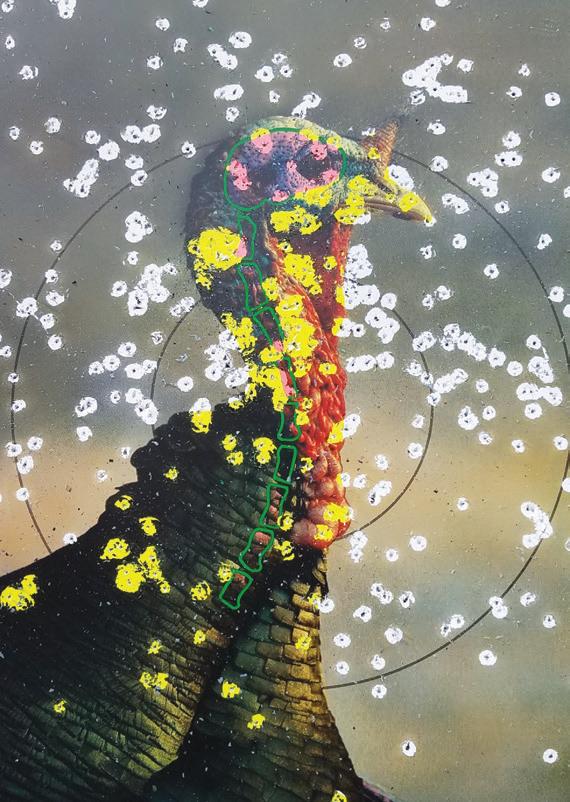
on a single 3V-CR2032 lithium battery, offers 10 brightness settings that are controlled by user-friendly buttons, and comes with an auto shut-off, four hours from the last button push. Made with lightweight aircraft-grade aluminum construction, the Tru•Tec Micro weighs in at 1 ounce. MSRP ranges from $235.99 to $294.99, depending on the model.
Most shooters who have used red dot optics know about the Trijicon RMR, or Ruggedized Miniature Reflex sight. This is the sight that I happened to mount on a shotgun for a trip to the
shotgun course at the Gunsite Academy in Paulden, Arizona, a few years ago. But the thinner, lower-profile Trijicon RMRcc is designed for concealed carry and provides fast, both-eyes-open target acquisition and accurate aiming. It is a great addition to the extensive line of durable reflex optics offered by Trijicon. The RMRcc keeps all the great features of the RMR, including easy-to-use buttons, a common 2032 battery with up to four years of illumination, and a wide variety of mounts to fit today’s most popular concealed carry pistols. The RMRcc is available in either a 3.25- or 6.5-MOA dot size and provides a bright, illuminated aiming point under any condition. The RMRcc is parallax-free with superior accuracy. MSRP is $699.
If you have had trouble missing turkeys of late, put a red dot optic on your shotgun and thank me later. That way you can enjoy the sausage, grits and gravy at the Pine Top later that morning. Have another cup of coffee on me.
Editor’s note: Larry Case has been a devoted outdoorsman since he was a child. He will admit to an addiction to turkey hunting (spring and fall), but refuses any treatment. He enjoys the company of gobblers and cur dogs that are loud and people who speak the truth softly. Case served 36 years as a game warden in West Virginia and retired with the rank of district captain. You can

80 American Shooting Journal // April 2024
Trijicon RMRcc. (TRIJICON)
Chokes also help determine how many pellets you get in the turkey kill zone. A TruGlo Head-Banger choke delivered this tight spread at 35 yards. (TRUGLO)




THE ALL-AROUND BIG GAME BULLET
Iam often asked by prospective traveling hunters if there is one bullet that can handle all big game hunting. While I wish I could say that there is a definite answer, the wide variety of game species that can be hunted around the globe demands a variety of bullets, especially when we add the true heavyweights of Africa and Australia in the mix. So rather than try and force a round peg in a square hole, I’ll choose a

Can one size really fit all? Here are the cases for six different projectiles. half-dozen projectiles that are suited to a broad band of applications. Depending on what species you intend to pursue, your choice – and definition of an all-around bullet – might change. For example, a dedicated deer hunter might not have the same requirements as a hunter who wants a single projectile for pronghorn antelope, elk, aoudad and grizzly bear. The toughness of the species, the thickness of the bones and hide, and sometimes the sheer size of the species might dictate what type of projectile is called for.
THE NOSLER PARTITION
Despite being almost 80 years old now, the Nosler Partition remains one of our best choices, as it has a wonderful blend of both reliable expansion and dependable penetration. John Nosler had been frustrated by poor bullet performance on a bull moose in the 1940s, and had the brilliant idea to put a partition of gilding metal in the middle of the projectile, separating the lead cores. This partition keeps the rear core intact after impact, while allowing the front core to give the expansion that results in a large wound
BULLET BULLETIN americanshootingjournal.com 83 BROUGHT TO YOU BY
Whether factory-loaded or in component form, some bullets have earned the “all-around” moniker.
STORY BY PHIL MASSARO • PHOTOS BY MASSARO MEDIA GROUP

channel. That front core is soft enough to expand on thin-skinned game, and the bullet has enough penetration to handle animals as large and tough as Cape buffalo and grizzly bear. It makes a good deer bullet in common calibers, and will handle any North American game animal at common ranges. The Partition is a flat-based spitzer bullet, and while it has a decent ballistic coefficient value, it isn’t often chosen for long-range hunting. For those animals routinely taken at longer ranges – like Coues deer, or any of the wild sheep – a boattail bullet is usually chosen. And while the Partition gives accuracy good enough for the hunter, it often fails to deliver the hairsplitting accuracy of some of the more frangible designs. I like it for bears, for big-bodied deer (especially in smaller calibers), and for just about any game hunted at common ranges.
THE FEDERAL TERMINAL ASCENT
What do you get when you mate the design principles of Jack Carter’s Trophy Bonded Bear Claw with the modern high-BC-bullet features? The Federal Terminal Ascent.
This bullet features the proprietary Slipstream polymer tip – which resists deformation in flight and acts as a wedge to initiate expansion upon impact – and the AccuGroove technology, which reduces the
If you want to enhance the performance of a .270 Winchester or .30-06 Springfield, a Nosler Partition is a great way to go. It gives great penetration, and the front core is soft enough to make a large wound channel.


bearing surface without hurting the BC value. The Terminal Ascent is a boattail bullet with a short lead core at the front, chemically bonded to the thick copper jacket/base; the bullet is plated in nickel. Because of the bonded core, the Terminal Ascent is fully capable of handling close shots from magnum velocity cartridges, yet is soft enough at the nose to reliably expand at velocities as low as 1,250 feet per second. This bullet and its older brother, the Trophy Bonded Tip, give excellent penetration; in fact, you might have a difficult time recovering these bullets, as they commonly pass through even large animals. We’ve got a bullet perfectly suited to most of the common game species, near or far, but the Terminal Ascent line tops out at .30 caliber. If you have a penchant for the truly big game species, you’ll have to look elsewhere, but for the majority of
Headed to Alaska?
A .338 Winchester Magnum loaded with a 250-grain Nosler Partition is a tried-and-true combination.
your hunting, the Terminal Ascent will check a lot of boxes.
THE WOODLEIGH HYDROSTATICALLY STABILIZED SOLID
We have come to refer to the nonexpanding bullets designed for ultimate penetration as “solids,” as they are often of full-metal-jacket design, offering no expansion. For those situations where very thick skin and huge bones – consider the size of an elephant’s shoulder bones, and the 2 feet of honeycombed bone that comprises the skull – proved to be too much for the cup-and-core softpoint bullets of a century ago, a fully encapsulated bullet (with no lead showing at the nose) would get the job done. But though these solids gave excellent penetration, the wound channel would tend to stay at caliber dimension.
Enter the Woodleigh Hydrostatically
84 American Shooting Journal // April 2024
BULLET BULLETIN
The classic Nosler Partition makes a great allaround bullet, being fully capable of almost all big game hunting. The .375 H&H Magnum is well served by this tough bullet.

Stabilized Solid, a nonexpanding bullet that creates a large wound channel in a unique manner. A small dish or cup at the nose creates a cavitation bubble, clearing the path for the bullet and simultaneously destroying any blood-rich tissue. I have found that the Woodleigh “Hydro” creates a cylinder of bloodshot meat between 8 and 12 inches in diameter, depending upon the size of the animal struck. That small dish does expand very slightly, but nothing in the manner of a softpoint bullet. A domed polymer cap is often included at the nose of the projectile, used for ease of feeding in a box magazine, but that breaks away upon impact and plays no part in the terminal phase of the bullet. What the Hydro offers is the ultimate in penetration, but destroys vital tissue. I’ve killed smaller species like impala and reedbuck with this bullet, as well as elephant and Cape buffalo. If I were forced to reach for one projectile to wander the wilds of Africa, it’s the Woodleigh Hydro. Is it the best deer bullet? No, but it would certainly get the job done.
THE BARNES TSX
The brainchild of Mr. Randy Brooks, the lead-free Barnes TSX is the latest iteration of the original Barnes X – a bullet that gave me fits early on. I loved the idea of a bullet that wouldn’t experience jacket/core separation



americanshootingjournal.com 85
Federal’s Terminal Ascent – the youngest in the Trophy Bonded Bear Claw family –checks a whole bunch of boxes, from close shots with speedy cartridges to crosscanyon shots in the wind. This is a great design.
Nickel-plated, with the proprietary Slipstream polymer tip and a steep boattail, the Terminal Ascent has AccuGroove technology on the shank to best resist atmospheric drag.
Combine a great modern bullet like the Terminal Ascent with an efficient design like the .280 Ackley Improved and you have an all-around cartridge suitable for most hunting scenarios.
The .308 Winchester is already a great all-around cartridge; load it with the 175-grain Terminal Ascent and it just gets better.

at any velocity, but the first design simply didn’t shoot in any of my rifles, and I won’t even start on the copper fouling. But cut a few grooves in that bad boy, and – voilà! – the entire game is changed. Today’s TSX (Triple Shok eXpanding) is a great bullet, giving consistent velocities and hitting like a hammer. It is perfectly legal in any of those areas that prohibit the use of lead-core ammunition, and can handle

just about any species that doesn’t regularly require the use of a solid. Many African professional hunters swear by them, and they remain a very popular choice here in North America. If you prefer the higher BC for longer shots, Barnes offers the classic copper bullet in the TTSX variety, with a blue polymer tip, and the LRX design, specifically engineered for long-range performance. Whichever you choose,
you can count on a Barnes bullet to be strong, giving deep penetration even on quartering shots, and opening to a respectable diameter even at lowimpact velocities. It makes a great allaround choice.
THE HORNADY ELD-X
While projectile technology continues to progress, with both materials and construction quickly evolving, it is

In
BULLET BULLETIN 86 American Shooting Journal // April 2024
a classic safari cartridge like the .375 H&H Magnum or the .416 Rigby, a Woodleigh Hydro solid will handle any and all game that walks. It might not be the best long-range choice, but it works at bushveldt ranges.
The Woodleigh Hydrostatically Stabilized Solid gives all the penetration of the “solid” bullets, with a unique meplat that creates a cavitation bubble, destroying blood-rich tissue.
Author Phil Massaro used the 400-grain Woodleigh Hydro in his .404 Jeffery to take this huge-bodied bull elephant in Zimbabwe. Both body shots passed completely through the animal at 16 paces.



nice to see an example of a modern yet simple design that has proven itself across a good number of calibers and cartridges alike. The Hornady ELD-X (Extremely Low Drag – eXpanding) was not the first cup-and-core bullet to wear a boattail and a polymer tip, but their recognition of meplat deformation in flight and the resultant Heat Shield Tip, which ended that phenomenon, added up to a hunting

BULLET BULLETIN 88 American Shooting Journal // April 2024
If the .375 H&H Magnum is a great all-around cartridge (and beyond a doubt, it is), it becomes even more flexible when loaded with a Woodleigh Hydro Solid.
The lead-free Barnes TSX is a good all-around hunting bullet, as it gives deep penetration from any angle, and can extend the capability of a universal cartridge like the 9.3x62 Mauser.
Copper projectiles are longer than their lead-core counterparts, and the grooves cut in the shank reduce bearing surface and copper fouling alike.


americanshootingjournal.com 89


bullet that has made many happy faces over the last few years. With a highly concentric jacket, a profile consistent with long-range accuracy, and a sectional density that allows a cup-and-core bullet to give adequate penetration, Hornady’s ELD-X has




BULLET BULLETIN 90 American Shooting Journal // April 2024
Hornady’s ELD-X is a polymer-tipped boattail design with the accuracy attributes of the match bullets, in heavy-for-caliber weights that enhance sectional density, ballistic coefficient and retained weight. (HORNADY)
The 90-grain 6mm ELD-X helps better the capabilities of the .243 Winchester and 6mm Remington, and will flatten deer and antelope.
A speedy cartridge like the 6.5-300 Weatherby Magnum benefits from the structural rigidity of the Barnes bullet, especially the sleek, polymer-tipped Barnes LRX shown here.
The 6.5mm 143-grain ELD-X bullet can help take full advantage of that caliber’s potential, as it gives a flat trajectory and works great in the wind.



We have a “No Game, No Pay” policy. You can’t get that out West or anywhere else.


A Unique Big Game Hunting Ranch
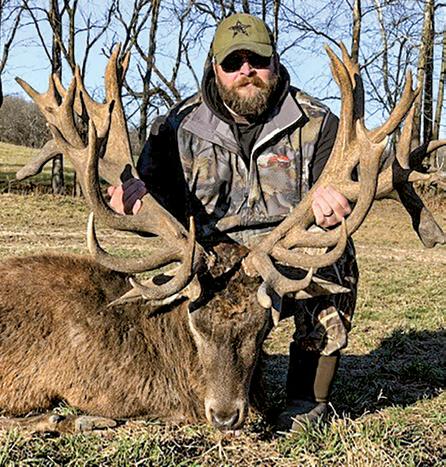
Nestled in the foothills of the Ozark Mountains in Missouri, High Adventure Ranch offers all of the excitement of western big game hunting without the costs and hassles.
Be prepared for a fair chase hunt! With over 3 square miles of prime natural habitat, our ranch provides challenges to even the most seasoned hunter, but our experienced guides and “No Game, No Pay” policy practically ensure that you won’t go home empty handed. In addition, High Adventure’s hunting season is year-round, allowing ample time to fit the most demanding schedule.
While our whitetail, elk, wild boar and red stag hunts top our hunter’s most popular lists, hunters from around the world have visited our ranch, hunting everything from American bison, black buck, fallow deer to Spanish goats and African game.
So, whether you desire a 10-point whitetail mount for your trophy room or simply the thrill and challenge of taking down one of our many elusive big game animals, High Adventure Ranch guarantees memories of an unparalleled hunting experience that will bring you back again and again.
Call Brad 314-578-4590 bpuff@highadventureranch.com highadventureranch.com
We are 8,000 miles closer than New Zealand. We are in Missouri and have red stag. Red Stag
Red Stag
Wild Boar
Whitetail
worked for me in a number of different situations, at ranges from up-closeand-personal to those in excess of three football fields. These projectiles tend to be heavy-for-caliber – lending a hand to both the sectional density and BC values – and that certainly helps in the terminal phase.
But as my father taught me at a young age, bullet placement is 95 percent of the game, and you’ve got to hit them in the right place in order to hold them. The Hornady ELD-X has proven to be wonderfully accurate in both factory-loaded and in component form, sometimes outperforming the ELD Match in a couple of my rifles. They are available in calibers from .22 to .338, so these are probably not
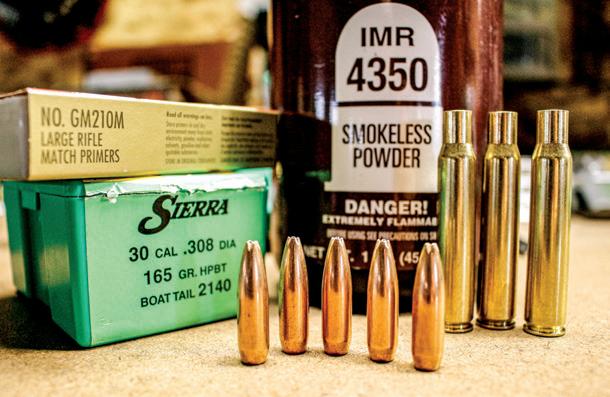

BULLET BULLETIN 92 American Shooting Journal // April 2024
Massaro used the ELD-X in 6.5 Creedmoor to take this mule deer buck at just under 200 yards; one shot handled him cleanly.
Sierra’s .30-caliber 165-grain hollowpoint boattail GameKing has a thick jacket – great for a hunting bullet – and is made to fly like their 168-grain MatchKing.


americanshootingjournal.com 93
well-suited to the pachyderms, but for the majority of North American game, you’ll be OK when loading an ELD-X bullet for your hunt.
THE SIERRA GAMEKING
Sometimes simple can be better; simple can be good. And for longer than I’ve been alive, the simple GameKing bullet from Sierra has been filling freezers. While Sierra is most famous for their MatchKing target bullets, the hunting bullets are wonderfully accurate, and like most cup-and-core designs, if they are of proper sectional density for the velocity and species targeted, they will kill quickly and effectively. There are a multitude of variants, including roundnose, spitzer boattails, boattail hollowpoints, and more.
I’ve personally used them for whitetails here in New York and caribou in Quebec, and I’ve loaded a whole bunch for friends and clients in pursuit of elk, moose, African


plains game, bear and more. I love the 165-grain HPBT in .30 caliber, as well as the 300-grain .375-caliber spitzer boattail; both have thick, tough jackets and can handle all sorts of big game work. In the age of hyper-technical bullets, it can be refreshing to use a simple cup-and-core that you can count on, and the Sierra GameKing has a rather universal appeal. If I were dedicated to pursuing just whitetail deer, I could live out my days with a Sierra GameKing in hand.
HONORABLE MENTIONS
There are other, similar designs that might be substituted for the makes and models I’ve chosen. Among them are the Swift A-Frame and Scirocco II (both excellent projectiles), the Nosler AccuBond and its brother the AccuBond Long Range, and the Norma Oryx. While no list is absolute – and I’ll be the first to admit that my own here is based on experiences in the field and at the range – I am always learning, and look forward to the next development in projectile technology.
BULLET BULLETIN 94 American Shooting Journal // April 2024
The 300-grain .375-caliber Sierra GameKing is a tough softpoint, giving excellent accuracy and helping to turn the various .375-caliber cartridges into long-range hunting cartridges.
A lead-core spitzer boattail, the Sierra GameKing can handle a wide variety of big game hunting applications, from African plains game to elk, moose and bear here in North America.



Trust HAMMER BULLETS for superior accuracy and better big game terminal performance.





PURE COPPER, LEAD-FREE


PATENTED DESIGN SATISFACTION GUARANTEED OR YOUR MONEY BACK.


americanshootingjournal.com 95
• 406-261-0010 • hammerbullets.com
406-261-5102
•
SIMPLY BETTER BULLETS


COMPANY SPOTLIGHT GRINDING HARDER
Barry Skolnick – a Florida entrepreneur, philanthropist, and art and car collector – zeros in a new business venture: manufacturing rifle and handgun ammo.
The idea of the American dream is that each citizen should be given equal opportunity to succeed through hard work. Hard work is the foundation and what ultimately will determine one’s success. Whatever one desires – whether it be happiness, work, money, cars – it can be achieved through hard work and following a moral code.
A great example of this would be Barry Skolnick of Grind Hard Ammo.
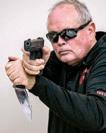
Through hard work and adhering to his guiding principles, Skolnick has become a highly successful entrepreneur and philanthropist in Florida. Skolnick is a man who leads by example in everything he does, whether in his role as president and managing director of BLS Asset Management Corp., or as the chairman of the executive board of trustees at Mount Sinai Medical Center in Miami Beach.
Skolnick is also on the board of directors for the Make-A-Wish Foundation (South Florida Chapter) and is the trustee of the Skolnick Family Charitable Trust, an independent foundation established in 1996 with a mission to support 501(c) (3) organizations to achieve excellence
in education, science, healthcare, law enforcement, and/or literacy.
He is a strong supporter of law enforcement and a founding cochairman of the Greater Miami Beach Police Foundation and New York’s Elite Police Foundation.
In addition to his work in the corporate and charitable sectors, Skolnick is a founding member of the Monticello Motor Club. He enjoys racing and is a preeminent automobile and art collector. Over the years, he has collected over 125 automobiles and iconic artwork from top contemporary, emerging and established artists. The cars and art are housed at his event space, Ikonick Motors.
LOOKING TO BRANCH out, Skolnick recently purchased Grind Hard Ammo because, as he states, “What redblooded American doesn’t like cars and shooting?”
With the knowledge, training and business experience Skolnick has acquired over the years, Grind Hard Ammo will surely succeed.
This is the mission statement that he and the Grind Hard crew put together:
“Grind Hard Ammo employees are committed to excellence in every aspect of the industry. As a vertically integrated ammunition company, all the employees of Grind Hard Ammo
americanshootingjournal.com 97
STORY AND PHOTOS BY PAUL PAWELA
Barry Skolnick shows off brass awaiting bullets at his latest venture, Grind Hard Ammo.
COMPANY SPOTLIGHT
take pride in their end-to-end control over the entire production process, from sourcing raw materials to delivering high-quality ammunition to their customers. The mission at Grind Hard is to provide reliable, accurate, and innovative ammunition solutions for shooting enthusiasts, law enforcement agencies, and military personnel.”
The core values of Grind Hard are quality (each round is meticulously crafted to the highest standards), innovation (including advanced ballistics research and cutting-edge manufacturing techniques), safety (all ammunition undergoes rigorous testing), sustainability (the company invests in sustainable practices to minimize waste), and customer focus (the customer is the heart of everything Grind Hard Ammo does).
As far as the “vertically integrated” piece of the mission statement, Grind Hard Ammo controls each step of the process, from selecting raw materials to manufacturing to research and development to distribution and finally to customer support.
Whether you are a competitive shooter seeking precision or a professional relying on products for the line of duty, Grind Hard Ammo invites you to experience their commitment to excellence.
IN PREPARATION FOR this article, I not only had the pleasure of interviewing Skolnick, but also visited the Grind Hard Ammo plant, based in Stuart, Florida, several times.
It is a facility to behold. First, it is the cleanest facility I have ever been to anywhere, let alone an ammo plant. Every worker – at every station and at all times – was doing their due diligence in quality control, all the while ensuring that their stations were in immaculate order.
Now, some might balk at the Grind Hard Ammo price point because it is a little bit higher than one might be used to paying. But I will defend the price point with these facts: 1) Grind



98 American Shooting Journal // April 2024
Skolnick has carried his love of art to the Grind Hard warehouse. The walls are covered with murals, neon lights, patriotic themes and even a metal sculpture of an eagle that hangs from the ceiling.






americanshootingjournal.com 99





Hard Ammo is first and foremost an American company in every aspect and, doggone it, that should matter, and 2) with Grind Hard’s quality control and adherence to SAAMI, or Sporting Arms and Ammunition Manufacturers’ Institute, standards, you don’t have to worry about their ammo ever blowing up your guns. That can’t be said of ammo coming from across the pond or even some of the cheaper ammo being made in the
United States.
The big question is, does it work?
In a matter of a month, I attended two major international instructor training courses – John Farnam’s rifle course and Sonny Puzikas’s Shooter/Fighter Matrix course – and was also invited to T6 Firearms’ demonstration/testing of their outstanding rifles.
Grind Hard Ammo was tested at each event. Over 1,500 5.56 rifle rounds were shot by Farnam, Gorka
COMPANY SPOTLIGHT 100 American Shooting Journal // April 2024
Grind Hard employees pride themselves on keeping their production facilities clean and doing due diligence in quality control throughout the entire production process.
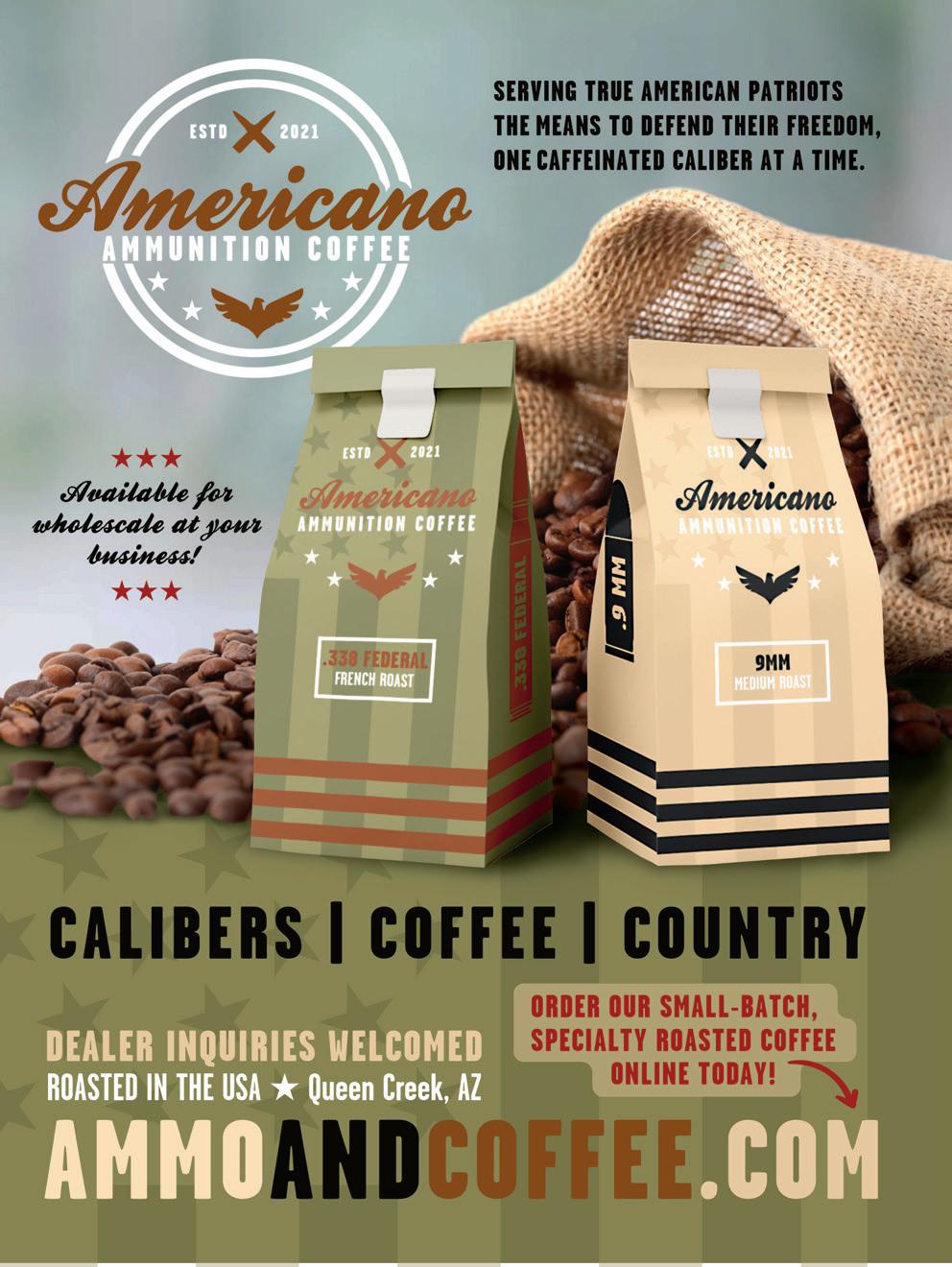
COMPANY SPOTLIGHT
Ibanez (grand master world champion shooter), Martin Reyna (international junior shooting sensation), as well as the T6 Firearms team. Another 1,000 rounds were shot by my wife, who shot at a local Glock match, Puzikas, his students, and myself.
In both rifle and pistol ammunition from Grind Hard Ammo, there were zero malfunctions and zero misfires.
Conclusion: I believe anyone can trust both Mr. Barry Skolnick and Grind Hard Ammo to protect their lives or the lives of others, and that is my two cents!
For more info on Grind Hard Ammo, go to grindhardammo.com. ★
Editor’s note: Author Paul Pawela is a nationally recognized firearms and self-defense expert. For his realistic self-defense training, see assaultcountertactics.com.



102 American Shooting Journal // April 2024
World champion and grand master shooter Gorka lbanez testing Grind Hard Ammo with his T6 rifle.
Luke Reninger (left), grand master shooter and brand ambassador for Grind Hard, stands alongside Mike Weldman, company production manager; Robert Monday, director of operations; and Ken Johnson, marketing and sales manager.
The company produces .223, 6.5 Creedmoor, .300 Blackout and .308 rifle rounds, and 9mm and .45 ACP handgun bullets.









we bridge the gap
warriors and
heroes sawmillttc.com 8524 Neely Ferry Rd, Laurens SC 29360
between
everyday
Elite Training for Specialized Forces Empowering Civilians: Resilience and Preparedness

BLACK POWDER LEVER-GUN FUN

Thirty bullets and targets at 25, 50 and 75 yards make for a great new club shooting match.
It was about a year and a half ago that my club, the Black River Buffalo Runners, started our Lever-Gun Matches at the Capitol City Rifle & Pistol Club near Olympia, Washington. These were an offshoot, so to speak, of the Meat Hunt, which is part of our annual Buffalo Camp. The Meat Hunt is a match where shooting is done with “camp guns” (rather than buffalo guns), and our shooters felt that it was enough fun to create a separate match, with its own rules, for black powder lever-actions.

Only a few shooters attended that first Lever-Gun Match, but it has certainly caught on since then. The match we just held had a dozen shooters taking part. That still sounds like small doin’s, but there were perhaps another dozen shooters who might have attended if it wasn’t for other circumstances. (We all have things to do.) Tom Witt, the match director, and I chatted about the need to do our shooting in relays should all of the shooters be in attendance. As Witt said, that would be an easy and pleasant problem to fix. We can easily expect
more shooters at our future matches.
FOR THE LEVER-GUN Matches, the repeating rifles must use ammunition loaded with black powder and lead bullets. The most popular rifles and loads so far have been the Uberti copies of the Model 1873 Winchester in .44-40 caliber, but other rifles have included copies of the 1866 Winchester, the more colorful Yellow Boy, and a few of those rifles chambered for the .45 Colt cartridge. Also seen on the firing line is a Model 1894 Winchester in .38-55, plus an old Model 1892 short rifle in .32-20. One .45-70 was used until that rifle’s owner found a .44-40 that won his heart, so now he’s a very dedicated .44-40 shooter. Basically, the first sentence of this paragraph wraps up the only rules or restrictions for the rifles.
At first, a year and a half ago, our Lever-Gun Matches involved both paper targets and steel gongs, with a mixture of shooting at both kinds of targets. The shooting at gongs was timed, not actually as part of the match, but the times were kept as a tiebreaker. For this portion, our rifles’ magazines were loaded, perhaps with just five cartridges, and shooting was done at a series of gongs from 50 to 100 yards,
with onlookers keeping track of hits and misses. Those shoots were fun and they required a lot of action. The only reason they were discontinued, temporarily, was because of some redesign of the black powder range. Those gongs will soon be put back up and we’ll do some of that shooting again.
For now, our matches involve three paper targets, posted at 25, 50 and either 75 or 100 yards, with 10 shots per target. That makes these matches 30-shot events, but those 30 shots do go very fast. That fast shooting makes these matches a great deal of fun, and after the awards, the gang retires to a watering hole for lunch, where the match is relived in boasts of victory or tales of woe.
THE MATCH WE just shot was our second for this year and the temperature at the range was a crisp 33 degrees when we got there. (The previous month it was only 18 degrees.) But the skies were clear and the sun soon had things getting warmer, maybe up to 45. The cold temps didn’t slow us down at all.
The first target, a big turkey, was posted at just 25 yards and when the line was ready, Witt said the range was hot. While 25 yards might sound a bit
americanshootingjournal.com 105
STORY AND PHOTOS BY MIKE NESBITT
Author Mike Nesbitt used a Uberti copy of the Winchester Model 1873, featuring a 30-inch barrel, during his shooting club’s recent Lever-Gun Match.
BLACK POWDER

close, that turkey has scoring rings that will make all but the most careful shooters come in with a score less than what they wanted or expected. The 10-X area of the target is just over the turkey’s eye. Head shots can score a 10, but then the scores quickly go down from there and any shot that misses the turkey is a complete miss with no score at all.
In a previous match, I tried too
hard and shot over the turkey’s head with two shots. This time I held lower, forcing myself to take a 6 o’clock hold on the bottom of the turkey’s head. Maybe I did that too well because I did have one rather low shot. But that’s OK; all my shots scored this time, and my score was 5 points higher than last time. When we are all shooting on the firing line, we do allow the rifles’ magazines to be loaded. However,
I only put five cartridges in the magazine at a time. When those five rounds are shot, I’ll load the rifle again with five more. Those 10 shots will finish the target, at which time a “ceasefire” is called and we go out to post the next targets.
One good reason for only loading the rifle with five cartridges at a time is because if a ceasefire is called during the match, the rifle would need to be completely unloaded and then placed in the racks behind the firing line with its action opened. No loaded guns are to be placed in those racks. It is simply easier to empty a rifle with fewer cartridges, but so far we’ve never had a reason to call a ceasefire, other than when a deer crossed the range in front of the targets. That deer is still happy, and so are we.
FOLLOWING THE TURKEY, we posted a good buffalo target at 50 yards. That again might sound like it is rather close, but please understand that we were not doing our shooting with long-range rifles. While the .44-40 I use is called

106 American Shooting Journal // April 2024
Competitors fire 10 shots at each target, including this turkey target, shot offhand at 25 yards.
Nesbitt fires a shot into the glaring morning sun. He credited his Quigley-style hat for shading his eyes and helping him score 85 of a possible 100 points at the 50-yard target.


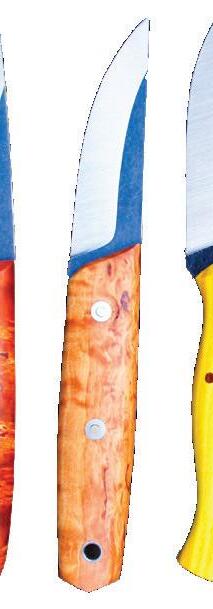










americanshootingjournal.com 107 Handcrafted Heirloom Quality Knives & Leather Goods made in america warlanderenterprises.com warlander_enterprises TheHawkenShop.com Now located in Oak Harbor, WA It’s more than a rifle, it’s history!
BLACK POWDER

the Long-Range model of the 1873 Winchester – made by Uberti and imported by Cimarron – because it has the 30-inch barrel, we can easily agree that the .44-40 is still a short-range cartridge. My loads use 205-grain bullets, cast from Accurate Molds’ No. 43-205C, which has a single but large lube groove, designed for black powder loads.
Beneath the bullets, I used 35 grains of Swiss 3Fg powder, which gives the bullet a velocity of about 1,350 feet
per second, which is fast for a black powder load in the old .44 W.C.F. And, on the buffalo target, I made sure my hold was at 6 o’clock on the 10-ring.
This 50-yard target was shot from the sitting position while resting our rifles’ barrels over cross-sticks. That makes for a fairly good and steady hold, but at that time in the morning we were shooting right into the sun. Such was the reason for wearing a good Quigleystyle hat, to keep my eyes in the shade. With the help of that hat, most of my

shots were pretty good, scoring an 85 out of the possible 100, and holding in a group that pleased me rather well.
Then came the 75-yard target, a single bull’s-eye, again shot from the sitting position while using cross-sticks. The last time we used this target, I held on the center of the bull’s-eye and scored a 90-2X but my group was on the high side, all above the center of the target. Remembering that, I held at 6 o’clock again and that cost me some points. The 6 o’clock hold was too low and that dropped my score down to 74 points.
SO FAR, I'VE only mentioned my scores. To give you an idea of the competition, I placed fourth for the day with a total of 239. The top shooter was Allen Cunniff, my Quigley partner, who I know I’ve mentioned before. He shoots a copy of the Henry rifle, also in .44-40 caliber, with a Lyman tang sight mounted behind the action. Cunniff is a hard man to beat with either rifle or revolver.
And speaking of revolvers, we had an after-match with our six-guns, again using black powder loads in their cartridges. This was also for fun and we shot at a small double-bull’s-eye target, offhand, at just 12 yards. The trick to this was that we shot with one-handed holds, shooting at the right bull’s-eye right-
108 American Shooting Journal // April 2024
The buffalo target, posted at 50 yards.
Mike Holeman won the after-match with his Flattop Colt in .44-40.

BLACK POWDER

handed and the left bull’s-eye left-handed. With my Uberti in .44 Russian, I got just four scoring hits on each of the bull’seyes. But Mike Holeman scored with all 10 shots! He was the winner, taking the
pot with a Flattop Colt copy in .44-40, available from Dixie Gun Works, using the same loads he puts in his rifle.
That concluded our morning’s match and prizes were awarded to all shooters, in





order of their rifle scores. The prizes are just little things that help us remember the matches, as if the good shooting wasn’t enough. Join us next time if you can, and bring your lever-gun. ★








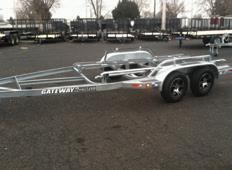
110 American Shooting Journal // April 2024
Reliable Quality Service & Craftsmanship For Over 50 Years! • NMMA Certified • All Steel Weld Frame, Fenders & Bunks • 2 YEAR WARRANTY Custom Boat Trailers 343 Thain Rd., Lewiston, Idaho • www.gateway-materials.com • 208-743-0720
Here’s the Lever-Gun Match gang, a good turnout for a morning shoot.

































































 Randy Luth once aspired to a career in printing, but when his interest in that waned, he turned to machining, a very profitable decision that eventually led to Luth’s founding of Defense Procurement Manufacturing Services and Luth-AR.
Randy Luth once aspired to a career in printing, but when his interest in that waned, he turned to machining, a very profitable decision that eventually led to Luth’s founding of Defense Procurement Manufacturing Services and Luth-AR.

 Luth, 70, competing in the recent 2024 Superstition Mountain Mystery 3-Gun Championship in Arizona, where he took second place in the Open Division Super Seniors category.
Luth, 70, competing in the recent 2024 Superstition Mountain Mystery 3-Gun Championship in Arizona, where he took second place in the Open Division Super Seniors category.

























































































 STORY BY FRANK JARDIM
closer look at Colt's Anaconda and King Cobra Target .22 LR, Korth's NXS 8 and Mongoose, Kimber's K6XS and K6S, and Taurus's Judge Home Defender.
STORY BY FRANK JARDIM
closer look at Colt's Anaconda and King Cobra Target .22 LR, Korth's NXS 8 and Mongoose, Kimber's K6XS and K6S, and Taurus's Judge Home Defender.





 Korth Mongoose. (NIGHTHAWK CUSTOM)
Korth NXS. (NIGHTHAWK CUSTOM)
Korth Mongoose. (NIGHTHAWK CUSTOM)
Korth NXS. (NIGHTHAWK CUSTOM)

























































































































